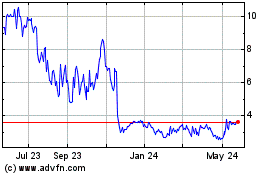false 0001827087 0001827087 2024-01-11 2024-01-11
UNITED STATES
SECURITIES AND EXCHANGE COMMISSION
Washington, D.C. 20549
FORM 8-K
CURRENT REPORT
Pursuant to Section 13 or 15(d)
of the Securities Exchange Act of 1934
Date of Report (Date of earliest event reported): January 11, 2024
VIGIL NEUROSCIENCE, INC.
(Exact name of registrant as specified in its charter)
|
|
|
|
|
| Delaware |
|
001-41200 |
|
85-1880494 |
| (State or other jurisdiction of incorporation) |
|
(Commission File Number) |
|
(I.R.S. Employer Identification No.) |
|
| Vigil Neuroscience, Inc. |
| 100 Forge Road, Suite 700 |
| Watertown, Massachusetts 02472 |
| (Address of principal executive offices, including zip code) |
(857) 254-4445
(Registrant’s telephone number, including area code)
Not Applicable
(Former Name or Former Address, if Changed Since Last Report)
Check the appropriate box below if the Form 8-K filing is intended to simultaneously satisfy the filing obligation of the registrant under any of the following provisions:
| ☐ |
Written communications pursuant to Rule 425 under the Securities Act (17 CFR 230.425) |
| ☐ |
Soliciting material pursuant to Rule 14a-12 under the Exchange Act (17 CFR 240.14a-12) |
| ☐ |
Pre-commencement communications pursuant to Rule 14d-2(b) under the Exchange Act (17 CFR 240.14d-2(b)) |
| ☐ |
Pre-commencement communications pursuant to Rule 13e-4(c) under the Exchange Act (17 CFR 240.13e-4(c)) |
Securities registered pursuant to Section 12(b) of the Act:
|
|
|
|
|
| Title of each class |
|
Trade Symbol(s) |
|
Name of each exchange on which registered |
| Common Stock, $0.0001 par value per share |
|
VIGL |
|
The Nasdaq Global Select Market |
Indicate by check mark whether the registrant is an emerging growth company as defined in Rule 405 of the Securities Act of 1933 (§ 230.405 of this chapter) or Rule 12b-2 of the Securities Exchange Act of 1934 (§ 240.12b-2 of this chapter).
Emerging growth company ☒
If an emerging growth company, indicate by check mark if the registrant has elected not to use the extended transition period for complying with any new or revised financial accounting standards provided pursuant to Section 13(a) of the Exchange Act. ☐
| Item 7.01 |
Regulation FD Disclosure. |
On January 11, 2024, Vigil Neuroscience, Inc. (the “Company”), delivered an updated corporate presentation furnished to this report as Exhibit 99.1 as part of the 42nd Annual J.P. Morgan Healthcare Conference in San Francisco.
The information under this Item 7.01, including Exhibit 99.1 hereto, is being furnished herewith and shall not be deemed “filed” for the purposes of Section 18 of the Securities Exchange Act of 1934, as amended (the “Exchange Act”), or otherwise subject to the liabilities of that section, nor shall such information be deemed incorporated by reference into any filing under the Securities Act of 1933, as amended, or the Exchange Act, except as expressly set forth by specific reference in such filing.
| Item 9.01. |
Financial Statements and Exhibits. |
(d) Exhibits
SIGNATURE
Pursuant to the requirements of the Securities Exchange Act of 1934, the registrant has duly caused this report to be signed on its behalf by the undersigned hereunto duly authorized.
|
|
|
|
|
|
|
|
|
|
|
Vigil Neuroscience, Inc. |
|
|
|
|
| Date: January 11, 2024 |
|
|
|
By: |
|
/s/ Ivana Magovčević-Liebisch |
|
|
|
|
|
|
Ivana Magovčević-Liebisch |
|
|
|
|
|
|
President and Chief Executive Officer |
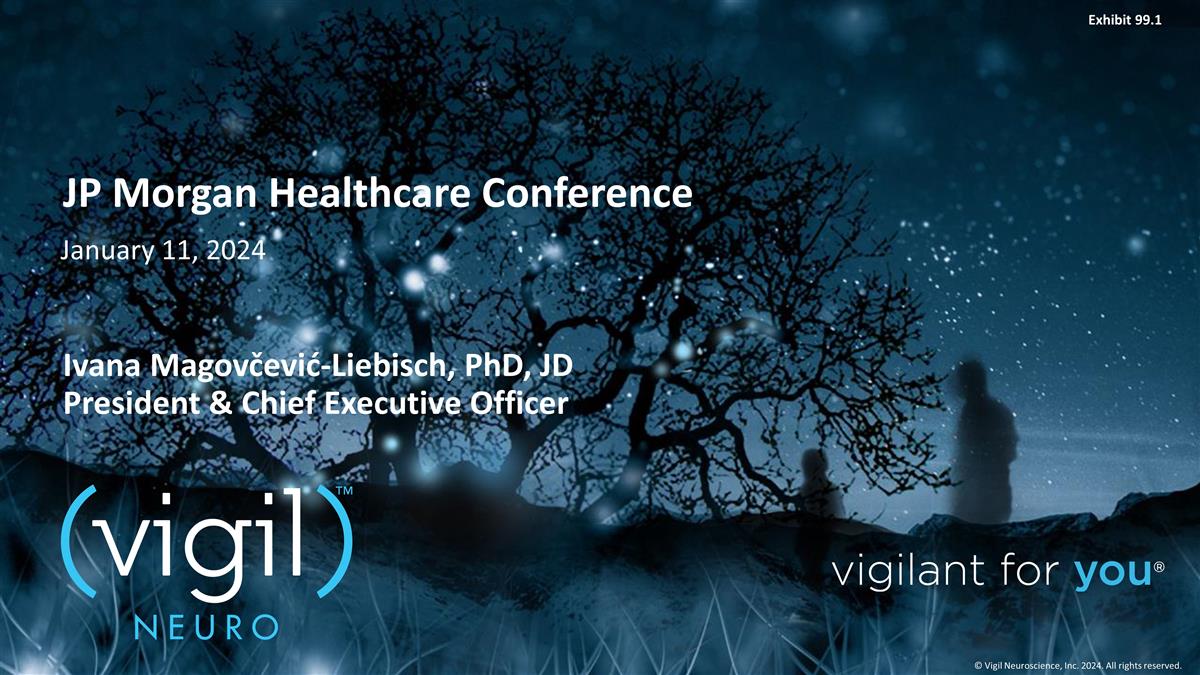
JP Morgan Healthcare Conference
January 11, 2024 © Vigil Neuroscience, Inc. 2024. All rights reserved. Ivana Magovčević-Liebisch, PhD, JD President & Chief Executive Officer Exhibit 99.1
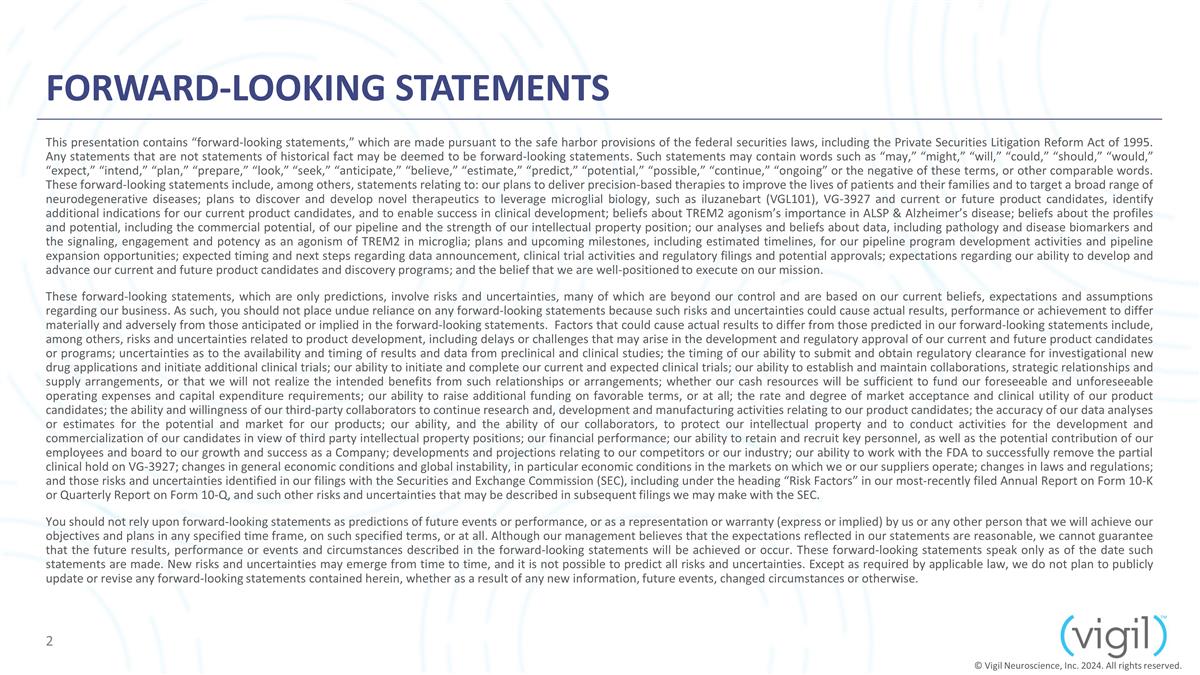
FORWARD-LOOKING STATEMENTS This
presentation contains “forward-looking statements,” which are made pursuant to the safe harbor provisions of the federal securities laws, including the Private Securities Litigation Reform Act of 1995. Any statements that are not
statements of historical fact may be deemed to be forward-looking statements. Such statements may contain words such as “may,” “might,” “will,” “could,” “should,” “would,”
“expect,” “intend,” “plan,” “prepare,” “look,” “seek,” “anticipate,” “believe,” “estimate,” “predict,” “potential,”
“possible,” “continue,” “ongoing” or the negative of these terms, or other comparable words. These forward-looking statements include, among others, statements relating to: our plans to deliver precision-based
therapies to improve the lives of patients and their families and to target a broad range of neurodegenerative diseases; plans to discover and develop novel therapeutics to leverage microglial biology, such as iluzanebart (VGL101), VG-3927 and
current or future product candidates, identify additional indications for our current product candidates, and to enable success in clinical development; beliefs about TREM2 agonism’s importance in ALSP & Alzheimer’s disease; beliefs
about the profiles and potential, including the commercial potential, of our pipeline and the strength of our intellectual property position; our analyses and beliefs about data, including pathology and disease biomarkers and the signaling,
engagement and potency as an agonism of TREM2 in microglia; plans and upcoming milestones, including estimated timelines, for our pipeline program development activities and pipeline expansion opportunities; expected timing and next steps regarding
data announcement, clinical trial activities and regulatory filings and potential approvals; expectations regarding our ability to develop and advance our current and future product candidates and discovery programs; and the belief that we are
well-positioned to execute on our mission. These forward‐looking statements, which are only predictions, involve risks and uncertainties, many of which are beyond our control and are based on our current beliefs, expectations and assumptions
regarding our business. As such, you should not place undue reliance on any forward-looking statements because such risks and uncertainties could cause actual results, performance or achievement to differ materially and adversely from those
anticipated or implied in the forward-looking statements. Factors that could cause actual results to differ from those predicted in our forward-looking statements include, among others, risks and uncertainties related to product development,
including delays or challenges that may arise in the development and regulatory approval of our current and future product candidates or programs; uncertainties as to the availability and timing of results and data from preclinical and clinical
studies; the timing of our ability to submit and obtain regulatory clearance for investigational new drug applications and initiate additional clinical trials; our ability to initiate and complete our current and expected clinical trials; our
ability to establish and maintain collaborations, strategic relationships and supply arrangements, or that we will not realize the intended benefits from such relationships or arrangements; whether our cash resources will be sufficient to fund our
foreseeable and unforeseeable operating expenses and capital expenditure requirements; our ability to raise additional funding on favorable terms, or at all; the rate and degree of market acceptance and clinical utility of our product candidates;
the ability and willingness of our third-party collaborators to continue research and, development and manufacturing activities relating to our product candidates; the accuracy of our data analyses or estimates for the potential and market for our
products; our ability, and the ability of our collaborators, to protect our intellectual property and to conduct activities for the development and commercialization of our candidates in view of third party intellectual property positions; our
financial performance; our ability to retain and recruit key personnel, as well as the potential contribution of our employees and board to our growth and success as a Company; developments and projections relating to our competitors or our
industry; our ability to work with the FDA to successfully remove the partial clinical hold on VG-3927; changes in general economic conditions and global instability, in particular economic conditions in the markets on which we or our suppliers
operate; changes in laws and regulations; and those risks and uncertainties identified in our filings with the Securities and Exchange Commission (SEC), including under the heading “Risk Factors” in our most-recently filed Annual Report
on Form 10-K or Quarterly Report on Form 10-Q, and such other risks and uncertainties that may be described in subsequent filings we may make with the SEC. You should not rely upon forward-looking statements as predictions of future events or
performance, or as a representation or warranty (express or implied) by us or any other person that we will achieve our objectives and plans in any specified time frame, on such specified terms, or at all. Although our management believes that the
expectations reflected in our statements are reasonable, we cannot guarantee that the future results, performance or events and circumstances described in the forward-looking statements will be achieved or occur. These forward-looking statements
speak only as of the date such statements are made. New risks and uncertainties may emerge from time to time, and it is not possible to predict all risks and uncertainties. Except as required by applicable law, we do not plan to publicly update or
revise any forward-looking statements contained herein, whether as a result of any new information, future events, changed circumstances or otherwise. 2 © Vigil Neuroscience, Inc. 2024. All rights reserved.
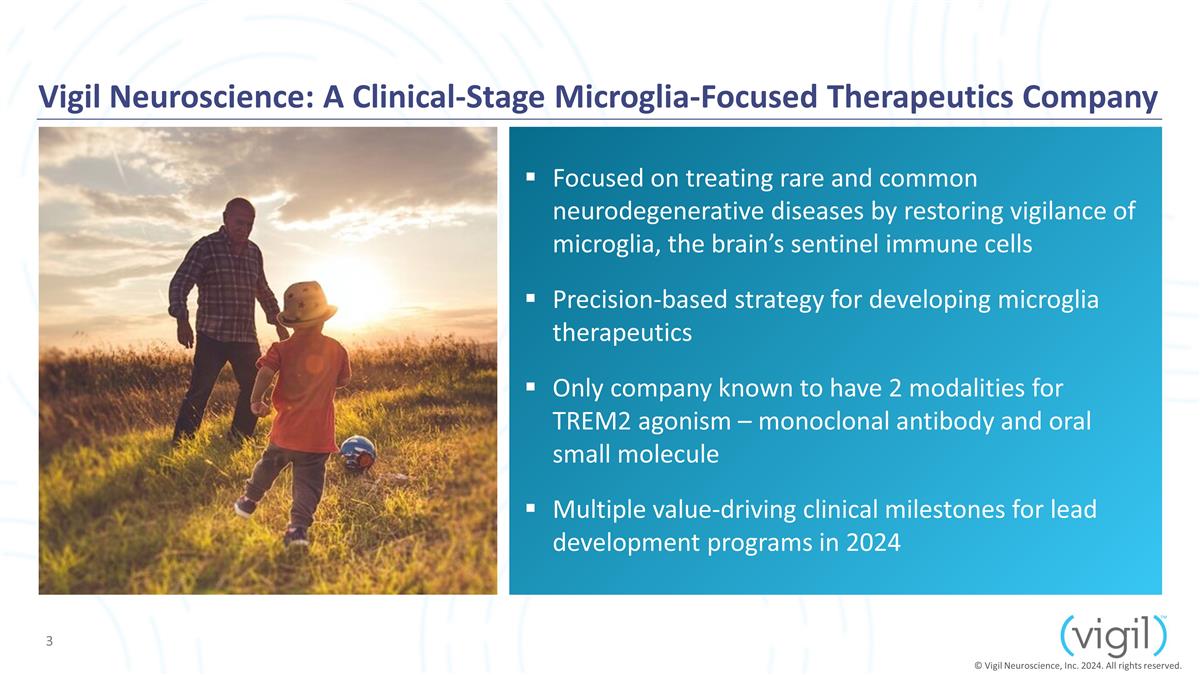
Vigil Neuroscience: A Clinical-Stage
Microglia-Focused Therapeutics Company Focused on treating rare and common neurodegenerative diseases by restoring vigilance of microglia, the brain’s sentinel immune cells Precision-based strategy for developing microglia therapeutics Only
company known to have 2 modalities for TREM2 agonism – monoclonal antibody and oral small molecule Multiple value-driving clinical milestones for lead development programs in 2024 © Vigil Neuroscience, Inc. 2024. All rights
reserved.
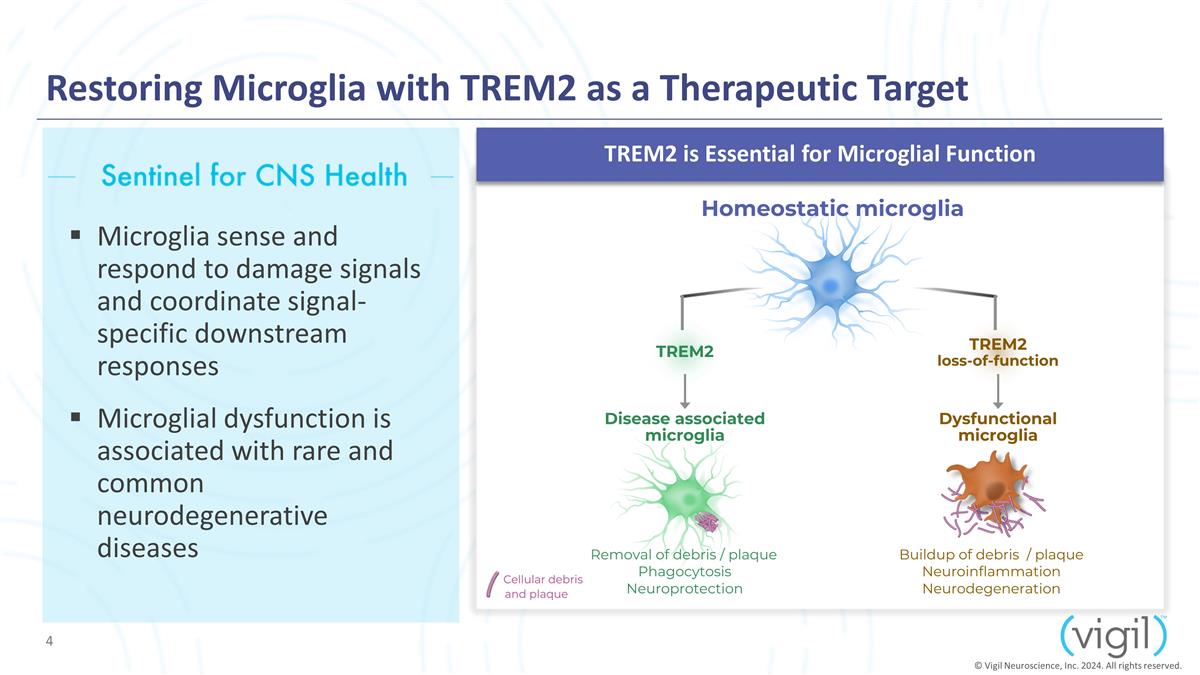
Restoring Microglia with TREM2 as a
Therapeutic Target © Vigil Neuroscience, Inc. 2024. All rights reserved. Microglia sense and respond to damage signals and coordinate signal-specific downstream responses Microglial dysfunction is associated with rare and common
neurodegenerative diseases TREM2 is Essential for Microglial Function
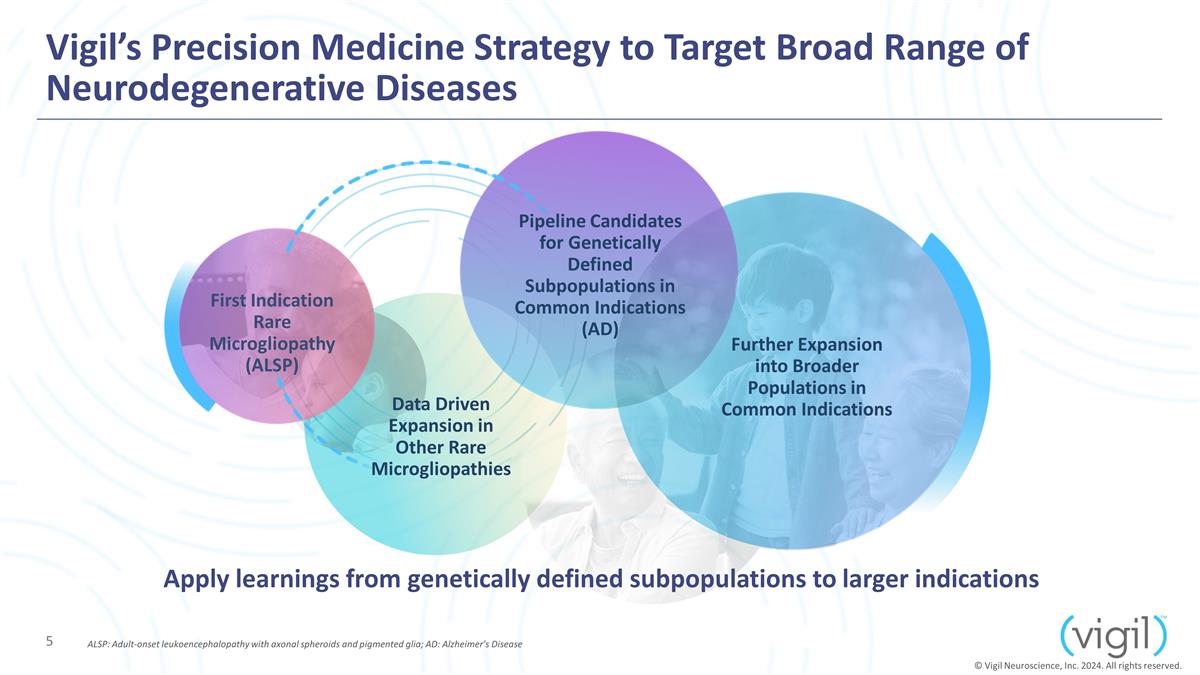
Vigil’s Precision Medicine
Strategy to Target Broad Range of Neurodegenerative Diseases First Indication Rare Microgliopathy (ALSP) Data Driven Expansion in Other Rare Microgliopathies Pipeline Candidates for Genetically Defined Subpopulations in Common Indications (AD)
Further Expansion into Broader Populations in Common Indications Apply learnings from genetically defined subpopulations to larger indications ALSP: Adult-onset leukoencephalopathy with axonal spheroids and pigmented glia; AD: Alzheimer’s
Disease © Vigil Neuroscience, Inc. 2024. All rights reserved.
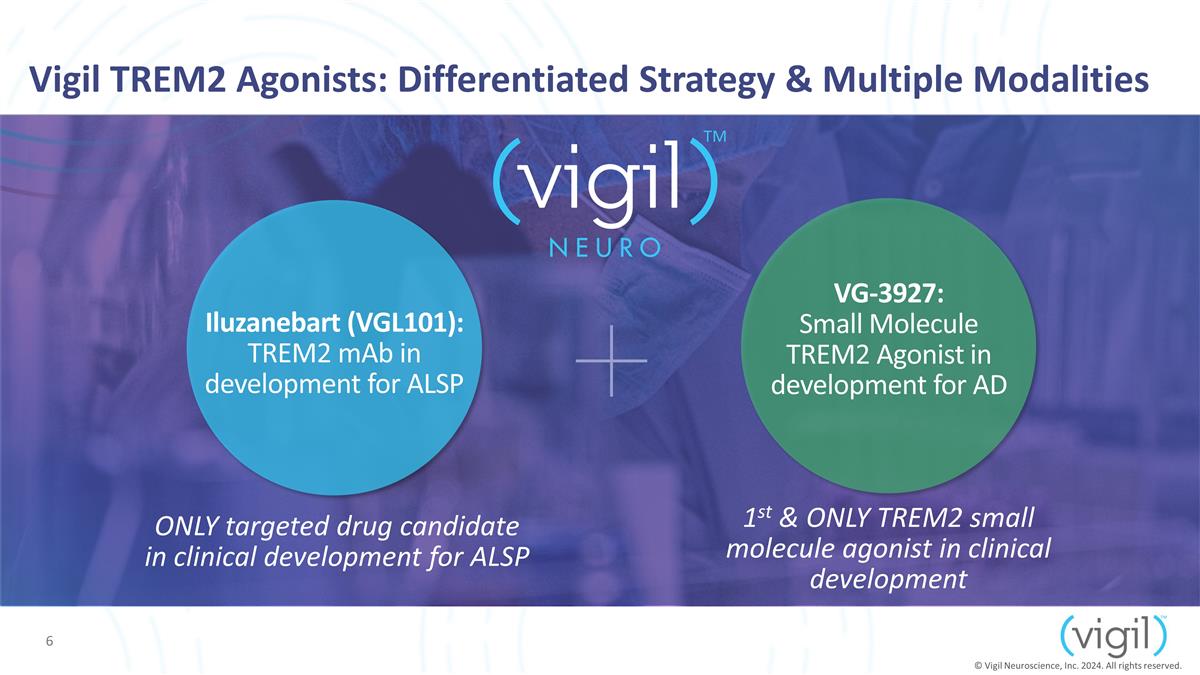
Vigil TREM2 Agonists: Differentiated
Strategy & Multiple Modalities Iluzanebart (VGL101): TREM2 mAb in development for ALSP VG-3927: Small Molecule TREM2 Agonist in development for AD ONLY targeted drug candidate in clinical development for ALSP 1st & ONLY TREM2 small molecule
agonist in clinical development © Vigil Neuroscience, Inc. 2024. All rights reserved. TM
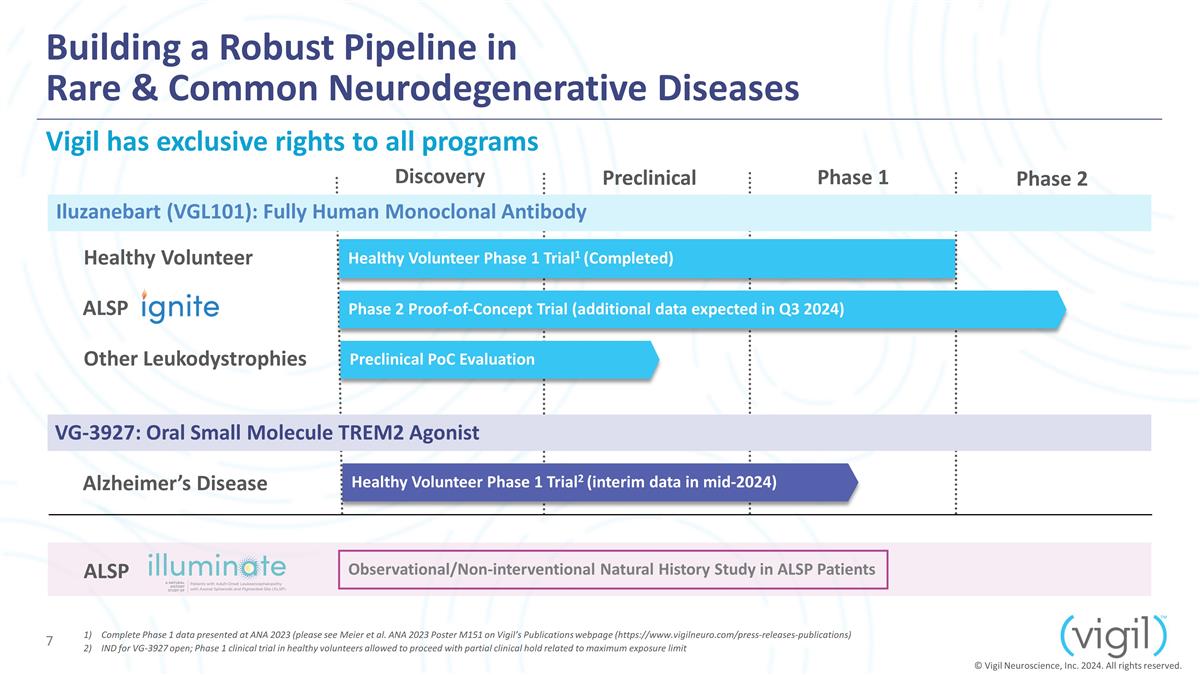
Building a Robust Pipeline in Rare
& Common Neurodegenerative Diseases Vigil has exclusive rights to all programs Alzheimer’s Disease Iluzanebart (VGL101): Fully Human Monoclonal Antibody Healthy Volunteer Phase 1 Trial1 (Completed) Healthy Volunteer VG-3927: Oral Small
Molecule TREM2 Agonist Discovery Preclinical Phase 1 Phase 2 Preclinical PoC Evaluation Other Leukodystrophies Complete Phase 1 data presented at ANA 2023 (please see Meier et al. ANA 2023 Poster M151 on Vigil’s Publications webpage
(https://www.vigilneuro.com/press-releases-publications) IND for VG-3927 open; Phase 1 clinical trial in healthy volunteers allowed to proceed with partial clinical hold related to maximum exposure limit ALSP Phase 2 Proof-of-Concept
Trial (additional data expected in Q3 2024) © Vigil Neuroscience, Inc. 2024. All rights reserved. ALSP Observational/Non-interventional Natural History Study in ALSP Patients Healthy Volunteer Phase 1 Trial2 (interim data in
mid-2024)
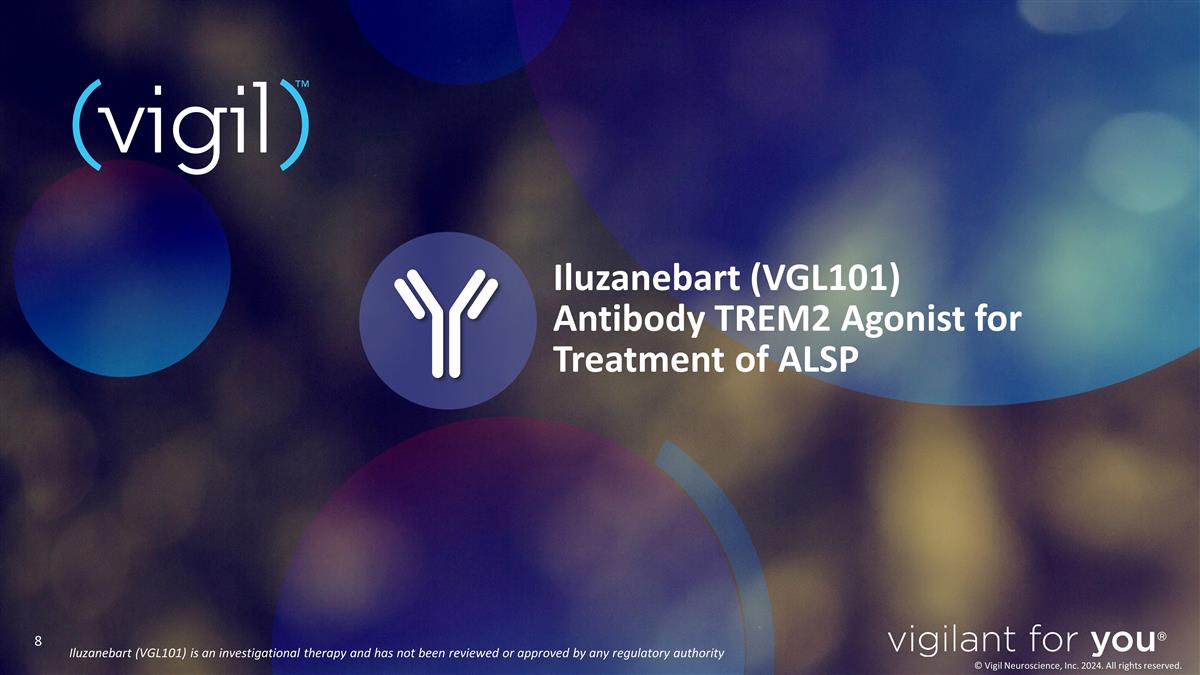
Iluzanebart (VGL101) Antibody TREM2
Agonist for Treatment of ALSP © Vigil Neuroscience, Inc. 2024. All rights reserved. Iluzanebart (VGL101) is an investigational therapy and has not been reviewed or approved by any regulatory authority
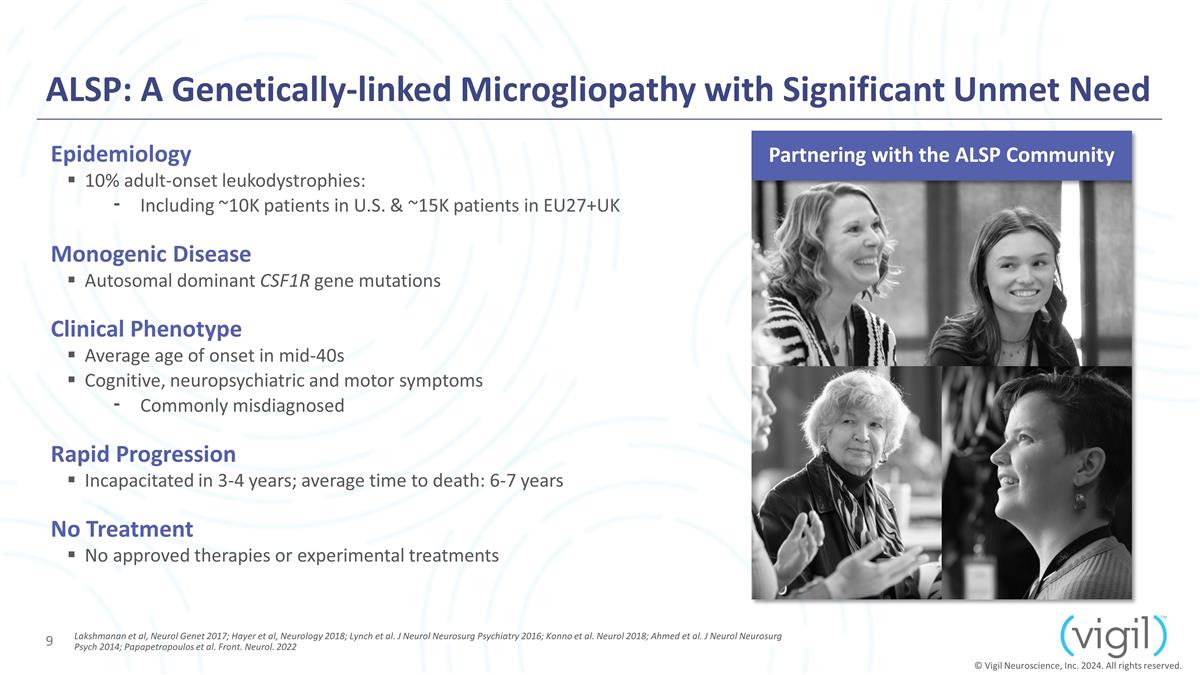
Epidemiology 10% adult-onset
leukodystrophies: Including ~10K patients in U.S. & ~15K patients in EU27+UK Monogenic Disease Autosomal dominant CSF1R gene mutations Clinical Phenotype Average age of onset in mid-40s Cognitive, neuropsychiatric and motor
symptoms Commonly misdiagnosed Rapid Progression Incapacitated in 3-4 years; average time to death: 6-7 years No Treatment No approved therapies or experimental treatments ALSP: A Genetically-linked Microgliopathy with Significant Unmet Need
Lakshmanan et al, Neurol Genet 2017; Hayer et al, Neurology 2018; Lynch et al. J Neurol Neurosurg Psychiatry 2016; Konno et al. Neurol 2018; Ahmed et al. J Neurol Neurosurg Psych 2014; Papapetropoulos et al. Front. Neurol. 2022 © Vigil
Neuroscience, Inc. 2024. All rights reserved. Partnering with the ALSP Community
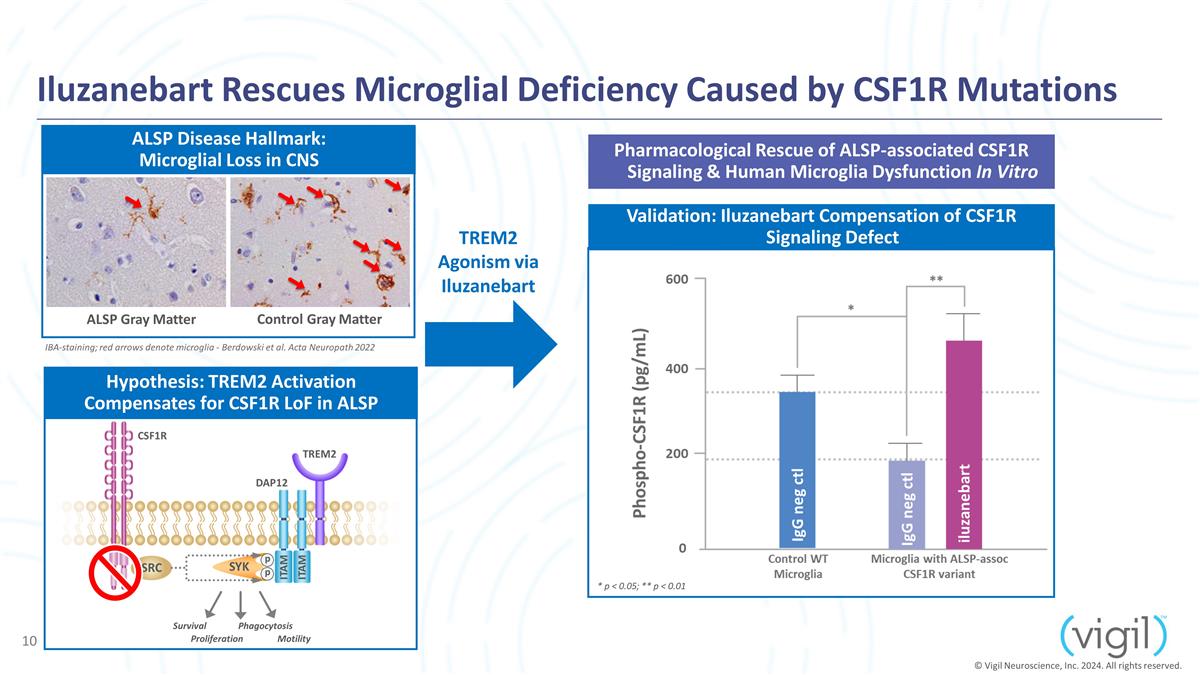
Validation: Iluzanebart
Compensation of CSF1R Signaling Defect Iluzanebart Rescues Microglial Deficiency Caused by CSF1R Mutations © Vigil Neuroscience, Inc. 2024. All rights reserved. IBA-staining; red arrows denote microglia - Berdowski et al. Acta Neuropath 2022
TREM2 Agonism via Iluzanebart Pharmacological Rescue of ALSP-associated CSF1R Signaling & Human Microglia Dysfunction In Vitro ALSP Disease Hallmark: Microglial Loss in CNS Control Gray Matter ALSP Gray Matter Survival Phagocytosis Proliferation
Motility Hypothesis: TREM2 Activation Compensates for CSF1R LoF in ALSP * p < 0.05; ** p < 0.01
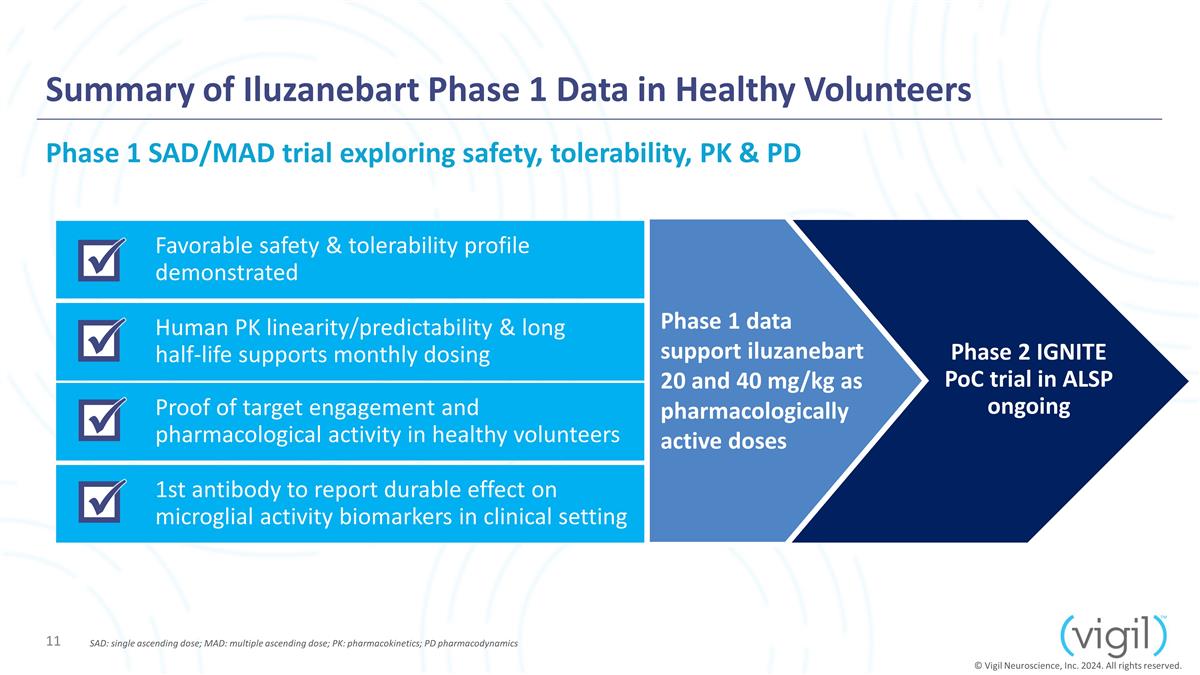
Proof of target engagement and
pharmacological activity in healthy volunteers 1st antibody to report durable effect on microglial activity biomarkers in clinical setting Summary of Iluzanebart Phase 1 Data in Healthy Volunteers SAD: single ascending dose; MAD: multiple ascending
dose; PK: pharmacokinetics; PD pharmacodynamics Favorable safety & tolerability profile demonstrated Human PK linearity/predictability & long half-life supports monthly dosing ü ü ü ü Phase 1 data support
iluzanebart 20 and 40 mg/kg as pharmacologically active doses Phase 2 IGNITE PoC trial in ALSP ongoing © Vigil Neuroscience, Inc. 2024. All rights reserved. Phase 1 SAD/MAD trial exploring safety, tolerability, PK & PD
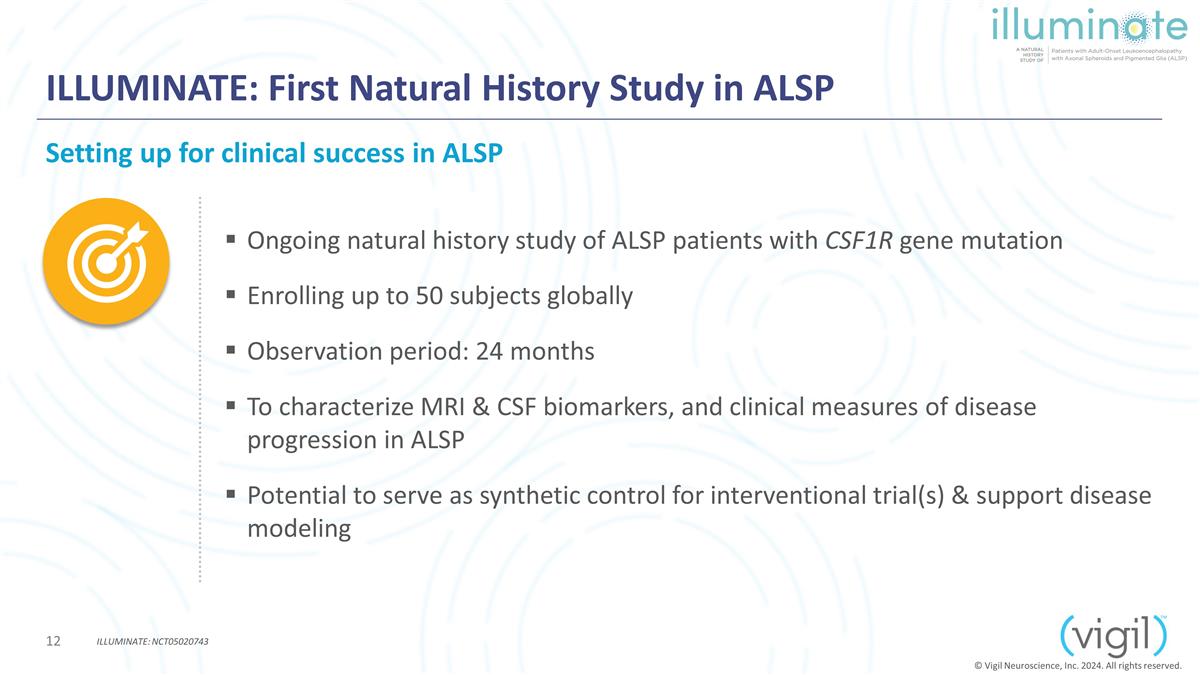
ILLUMINATE: First Natural History
Study in ALSP ILLUMINATE: NCT05020743 © Vigil Neuroscience, Inc. 2024. All rights reserved. Ongoing natural history study of ALSP patients with CSF1R gene mutation Enrolling up to 50 subjects globally Observation period: 24 months To
characterize MRI & CSF biomarkers, and clinical measures of disease progression in ALSP Potential to serve as synthetic control for interventional trial(s) & support disease modeling Setting up for clinical success in ALSP
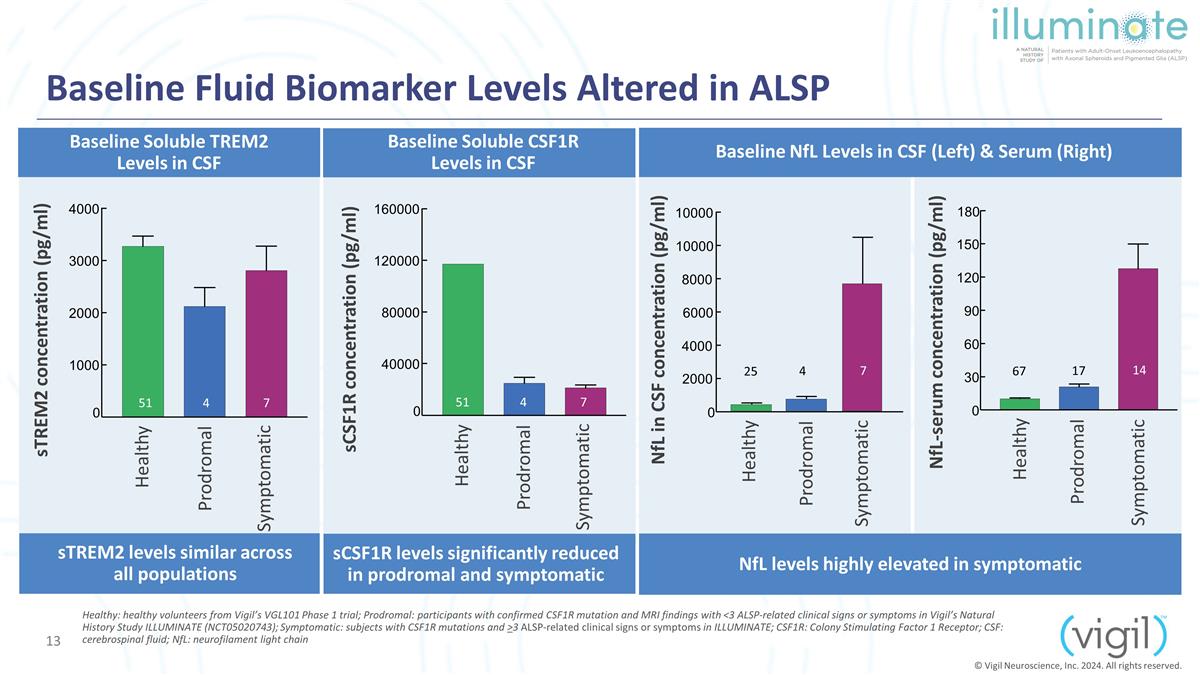
Baseline Fluid Biomarker Levels
Altered in ALSP NfL levels highly elevated in symptomatic sTREM2 levels similar across all populations sCSF1R levels significantly reduced in prodromal and symptomatic sTREM2 concentration (pg/ml) 0 1000 2000 3000 4000 51 4 7 Healthy Prodromal
Symptomatic sCSF1R concentration (pg/ml) 0 40000 80000 120000 160000 51 4 7 Healthy Prodromal Symptomatic 0 2000 4000 6000 8000 10000 7 Healthy Prodromal Symptomatic 10000 NfL in CSF concentration (pg/ml) 0 30 60 90 120 150 67 17 14 Healthy
Prodromal Symptomatic NfL-serum concentration (pg/ml) 180 25 4 Baseline Soluble TREM2 Levels in CSF Baseline Soluble CSF1R Levels in CSF Baseline NfL Levels in CSF (Left) & Serum (Right) © Vigil Neuroscience, Inc. 2024. All rights reserved.
Healthy: healthy volunteers from Vigil’s VGL101 Phase 1 trial; Prodromal: participants with confirmed CSF1R mutation and MRI findings with <3 ALSP-related clinical signs or symptoms in Vigil’s Natural History Study ILLUMINATE
(NCT05020743); Symptomatic: subjects with CSF1R mutations and >3 ALSP-related clinical signs or symptoms in ILLUMINATE; CSF1R: Colony Stimulating Factor 1 Receptor; CSF: cerebrospinal fluid; NfL: neurofilament light chain
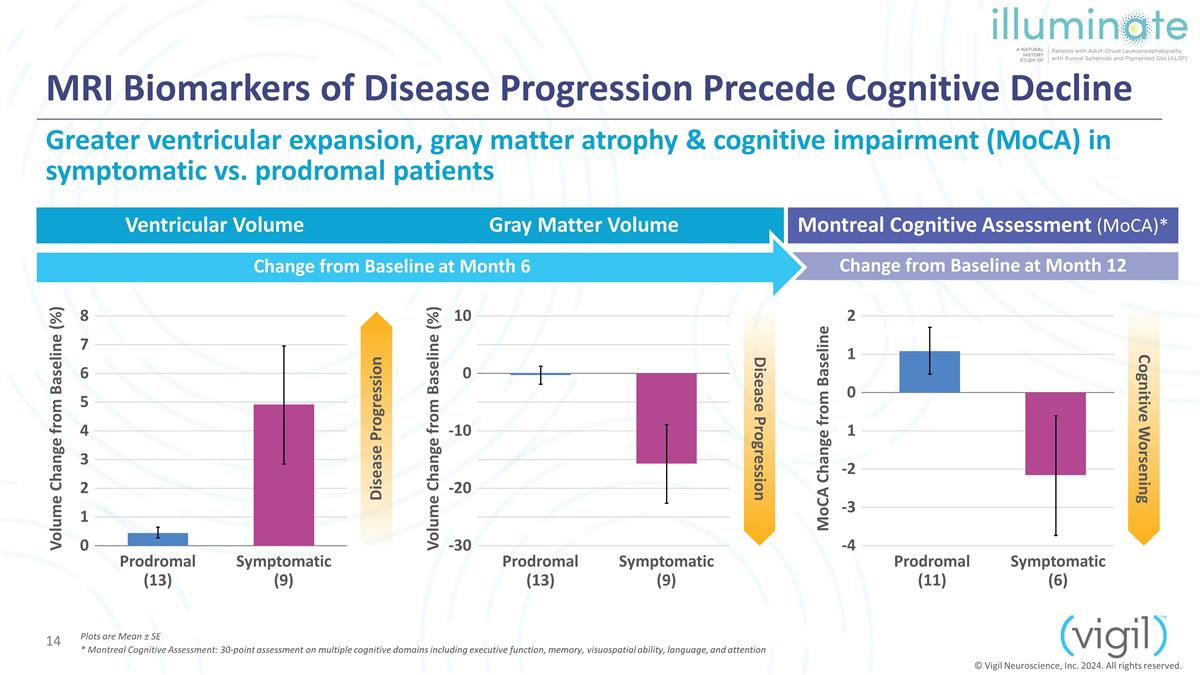
Gray Matter Volume Change from
Baseline at Month 12 Montreal Cognitive Assessment (MoCA)* MoCA Change from Baseline Prodromal (11) Symptomatic (6) Cognitive Worsening 2 1 0 1 -2 -3 -4 MRI Biomarkers of Disease Progression Precede Cognitive Decline Plots are Mean ± SE *
Montreal Cognitive Assessment: 30-point assessment on multiple cognitive domains including executive function, memory, visuospatial ability, language, and attention Volume Change from Baseline (%) Prodromal (13) Symptomatic (9) Volume Change from
Baseline (%) Prodromal (13) Symptomatic (9) Disease Progression Disease Progression 8 7 6 5 4 3 2 1 0 10 0 -10 -20 -30 Greater ventricular expansion, gray matter atrophy & cognitive impairment (MoCA) in symptomatic vs. prodromal patients
Ventricular Volume © Vigil Neuroscience, Inc. 2024. All rights reserved. Change from Baseline at Month 6
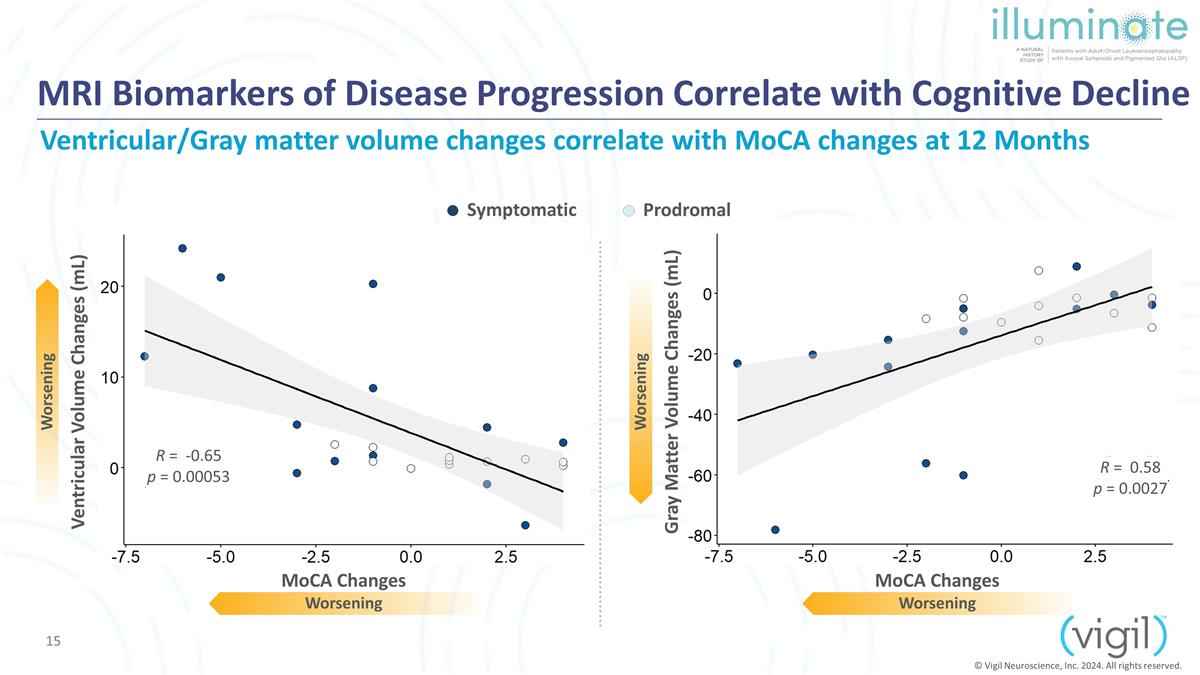
MRI Biomarkers of Disease
Progression Correlate with Cognitive Decline Worsening Worsening © Vigil Neuroscience, Inc. 2024. All rights reserved. Worsening Worsening Ventricular/Gray matter volume changes correlate with MoCA changes at 12 Months Prodromal Symptomatic
Ventricular Volume Changes (mL) MoCA Changes Gray Matter Volume Changes (mL) MoCA Changes R = -0.65 p = 0.00053 R = 0.58 p = 0.0027
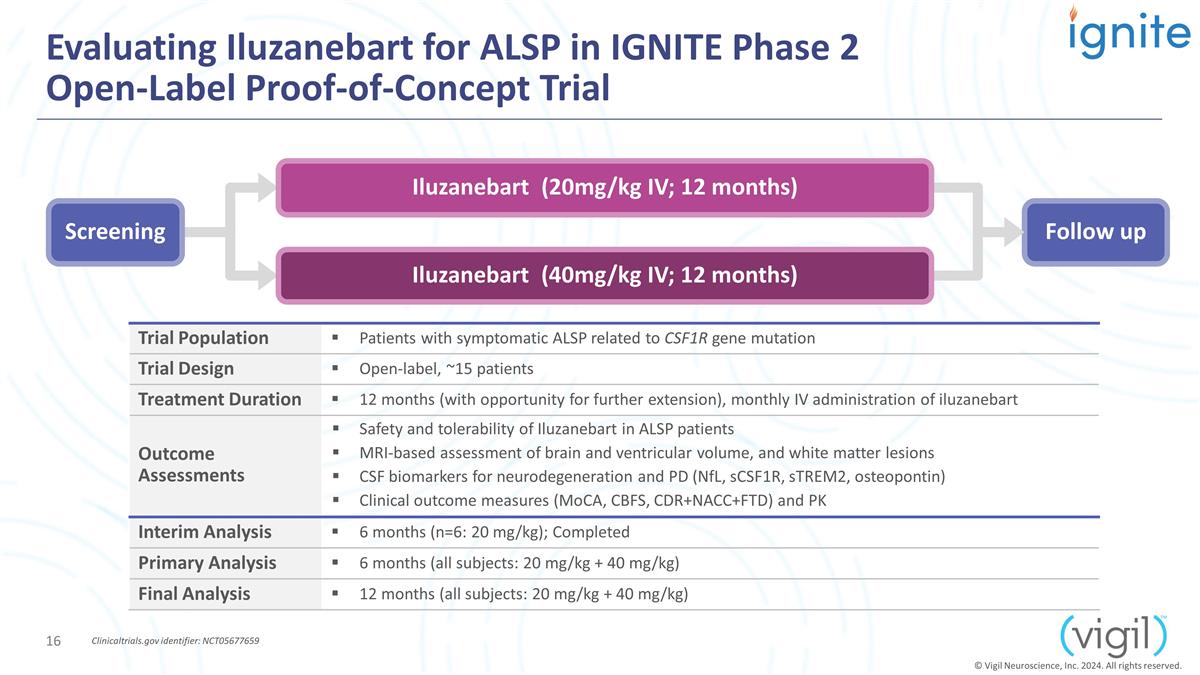
Evaluating Iluzanebart for ALSP in
IGNITE Phase 2 Open-Label Proof-of-Concept Trial © Vigil Neuroscience, Inc. 2024. All rights reserved. Follow up Trial Population Patients with symptomatic ALSP related to CSF1R gene mutation Trial Design Open-label, ~15
patients Treatment Duration 12 months (with opportunity for further extension), monthly IV administration of iluzanebart Outcome Assessments Safety and tolerability of Iluzanebart in ALSP patients MRI-based assessment of brain and ventricular
volume, and white matter lesions CSF biomarkers for neurodegeneration and PD (NfL, sCSF1R, sTREM2, osteopontin) Clinical outcome measures (MoCA, CBFS, CDR+NACC+FTD) and PK Clinicaltrials.gov identifier: NCT05677659 Screening Iluzanebart (20mg/kg IV;
12 months) Iluzanebart (40mg/kg IV; 12 months) Interim Analysis 6 months (n=6: 20 mg/kg); Completed Primary Analysis 6 months (all subjects: 20 mg/kg + 40 mg/kg) Final Analysis 12 months (all subjects: 20 mg/kg + 40 mg/kg)
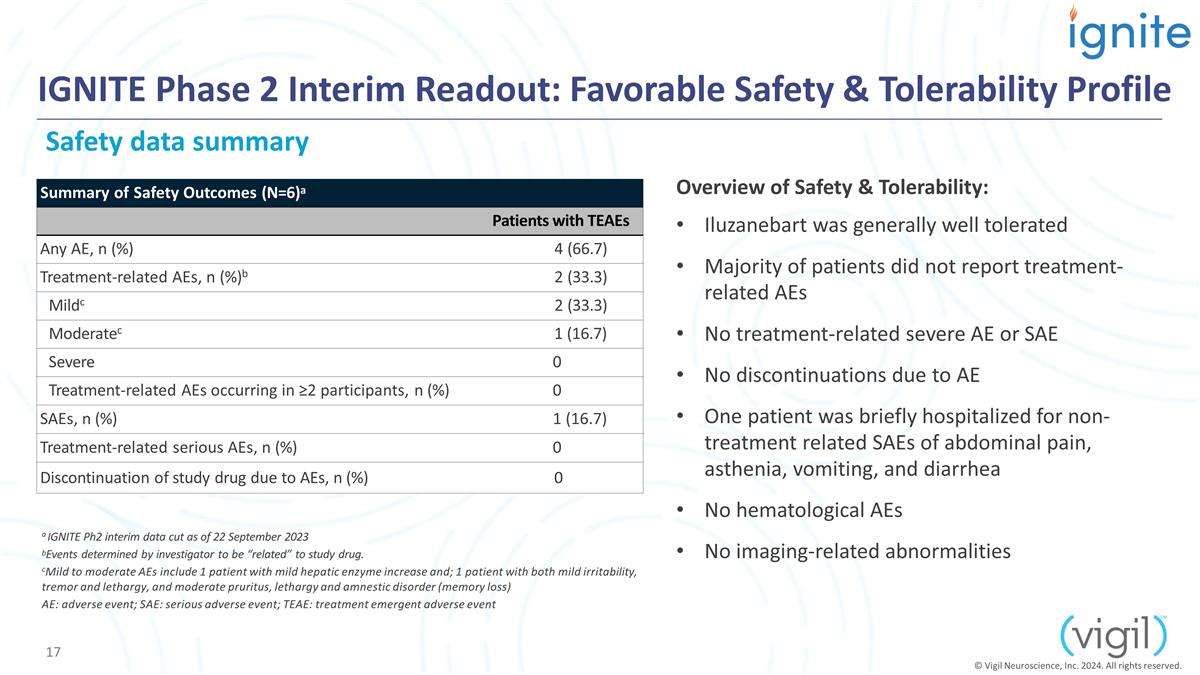
IGNITE Phase 2 Interim
Readout: Favorable Safety & Tolerability Profile Safety data summary Summary of Safety Outcomes (N=6)a Patients with TEAEs Any AE, n (%) 4 (66.7) Treatment-related AEs, n (%)b 2 (33.3) Mildc
2 (33.3) Moderatec 1 (16.7) Severe 0 Treatment-related AEs occurring in ≥2 participants, n (%) 0 SAEs, n (%) 1 (16.7) Treatment-related serious AEs, n (%) 0 Discontinuation of study drug due to
AEs, n (%) 0 a IGNITE Ph2 interim data cut as of 22 September 2023 bEvents determined by investigator to be “related” to study drug. cMild to moderate AEs include 1 patient with mild hepatic enzyme increase and;
1 patient with both mild irritability, tremor and lethargy, and moderate pruritus, lethargy and amnestic disorder (memory loss) AE: adverse event; SAE: serious adverse event; TEAE: treatment emergent adverse event Overview of Safety &
Tolerability: Iluzanebart was generally well tolerated Majority of patients did not report treatment-related AEs No treatment-related severe AE or SAE No discontinuations due to AE One patient was briefly hospitalized for non-treatment related
SAEs of abdominal pain, asthenia, vomiting, and diarrhea No hematological AEs No imaging-related abnormalities © Vigil Neuroscience, Inc. 2024. All rights reserved.
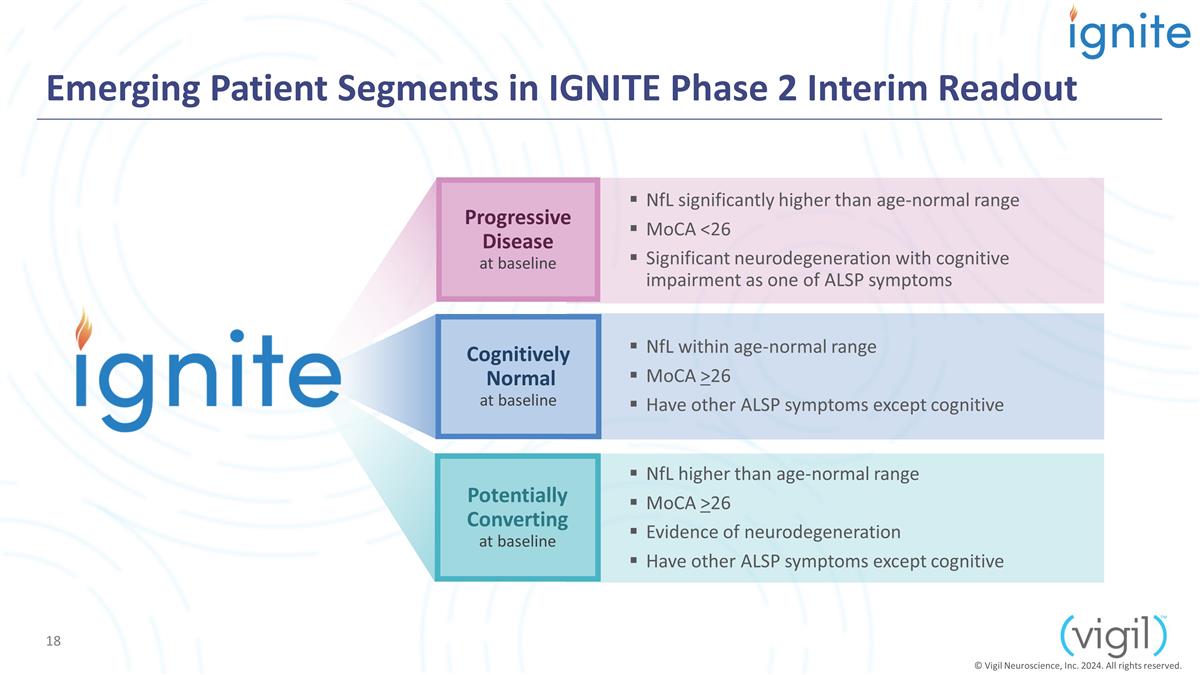
Emerging Patient Segments in IGNITE
Phase 2 Interim Readout NfL significantly higher than age-normal range MoCA <26 Significant neurodegeneration with cognitive impairment as one of ALSP symptoms NfL higher than age-normal range MoCA >26 Evidence of neurodegeneration Have other
ALSP symptoms except cognitive Progressive Disease at baseline NfL within age-normal range MoCA >26 Have other ALSP symptoms except cognitive Cognitively Normal at baseline Potentially Converting at baseline © Vigil Neuroscience, Inc. 2024.
All rights reserved.
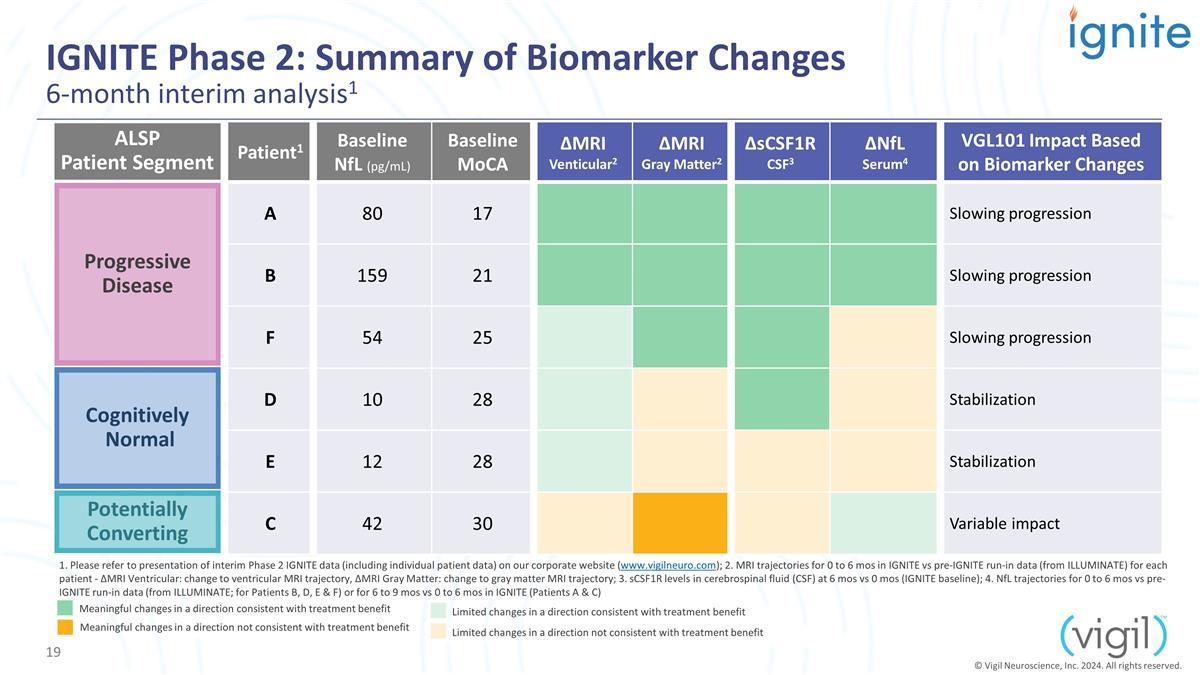
Progressive Disease Cognitively
Normal Potentially Converting IGNITE Phase 2: Summary of Biomarker Changes 6-month interim analysis1 Patient1 Baseline NfL (pg/mL) Baseline MoCA ΔMRI Venticular2 ΔMRI Gray Matter2 ΔsCSF1R CSF3 ΔNfL Serum4 VGL101 Impact Based on
Biomarker Changes A 80 17 Slowing progression B 159 21 Slowing progression F 54 25 Slowing progression D 10 28 Stabilization E 12 28 Stabilization C 42 30 Variable impact 1. Please refer to presentation of interim Phase 2 IGNITE data (including
individual patient data) on our corporate website (www.vigilneuro.com); 2. MRI trajectories for 0 to 6 mos in IGNITE vs pre-IGNITE run-in data (from ILLUMINATE) for each patient - ΔMRI Ventricular: change to ventricular MRI trajectory,
ΔMRI Gray Matter: change to gray matter MRI trajectory; 3. sCSF1R levels in cerebrospinal fluid (CSF) at 6 mos vs 0 mos (IGNITE baseline); 4. NfL trajectories for 0 to 6 mos vs pre-IGNITE run-in data (from ILLUMINATE; for Patients B, D, E &
F) or for 6 to 9 mos vs 0 to 6 mos in IGNITE (Patients A & C) Meaningful changes in a direction consistent with treatment benefit Limited changes in a direction consistent with treatment benefit Limited changes in a direction not consistent with
treatment benefit Meaningful changes in a direction not consistent with treatment benefit ALSP Patient Segment © Vigil Neuroscience, Inc. 2024. All rights reserved.
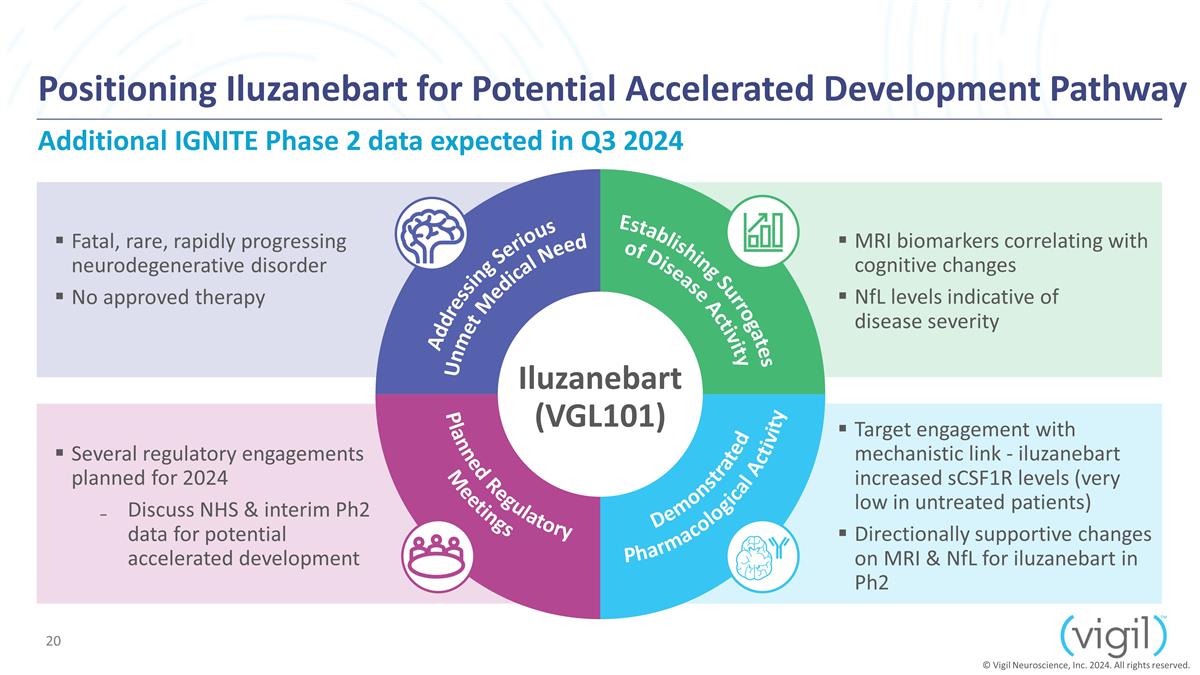
Positioning Iluzanebart for
Potential Accelerated Development Pathway Iluzanebart (VGL101) Target engagement with mechanistic link - iluzanebart increased sCSF1R levels (very low in untreated patients) Directionally supportive changes on MRI & NfL for iluzanebart in Ph2
MRI biomarkers correlating with cognitive changes NfL levels indicative of disease severity Fatal, rare, rapidly progressing neurodegenerative disorder No approved therapy Several regulatory engagements planned for 2024 Discuss NHS
& interim Ph2 data for potential accelerated development Addressing Serious Unmet Medical Need Demonstrated Pharmacological Activity Planned Regulatory Meetings Establishing Surrogates of Disease Activity © Vigil Neuroscience, Inc. 2024.
All rights reserved. Additional IGNITE Phase 2 data expected in Q3 2024
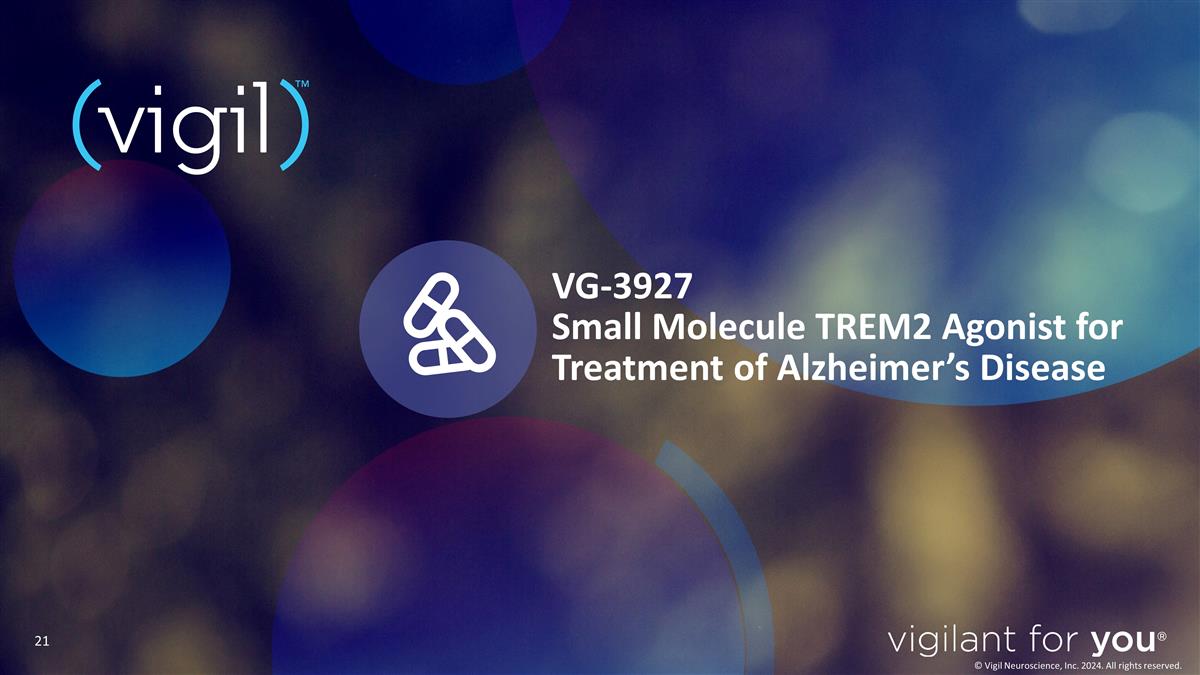
VG-3927 Small Molecule TREM2
Agonist for Treatment of Alzheimer’s Disease © Vigil Neuroscience, Inc. 2024. All rights reserved.
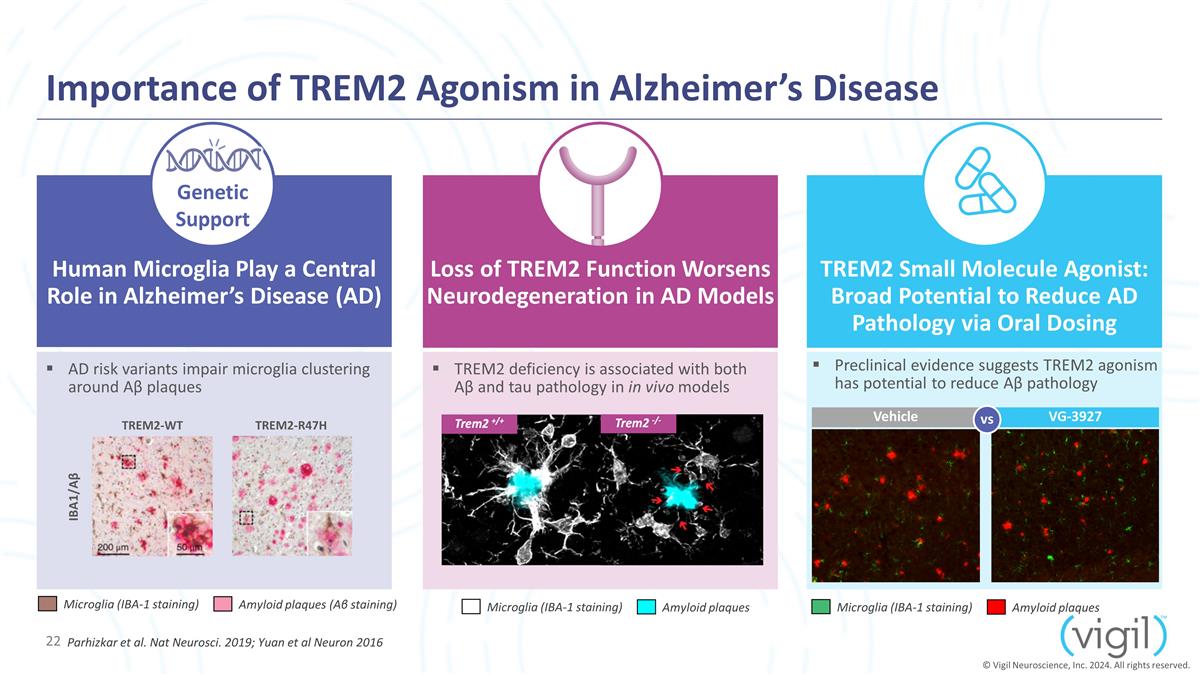
Human Microglia Play a Central Role
in Alzheimer’s Disease (AD) Loss of TREM2 Function Worsens Neurodegeneration in AD Models TREM2 Small Molecule Agonist: Broad Potential to Reduce AD Pathology via Oral Dosing AD risk variants impair microglia clustering around Aβ plaques
TREM2 deficiency is associated with both Aβ and tau pathology in in vivo models Importance of TREM2 Agonism in Alzheimer’s Disease TREM2-WT TREM2-R47H IBA1/Aβ Parhizkar et al. Nat Neurosci. 2019; Yuan et al Neuron 2016 Microglia
(IBA-1 staining) Amyloid plaques Microglia (IBA-1 staining) Amyloid plaques (Aβ staining) Vehicle VG-3927 vs Preclinical evidence suggests TREM2 agonism has potential to reduce Aβ pathology Microglia (IBA-1 staining) Amyloid plaques
Genetic Support © Vigil Neuroscience, Inc. 2024. All rights reserved.
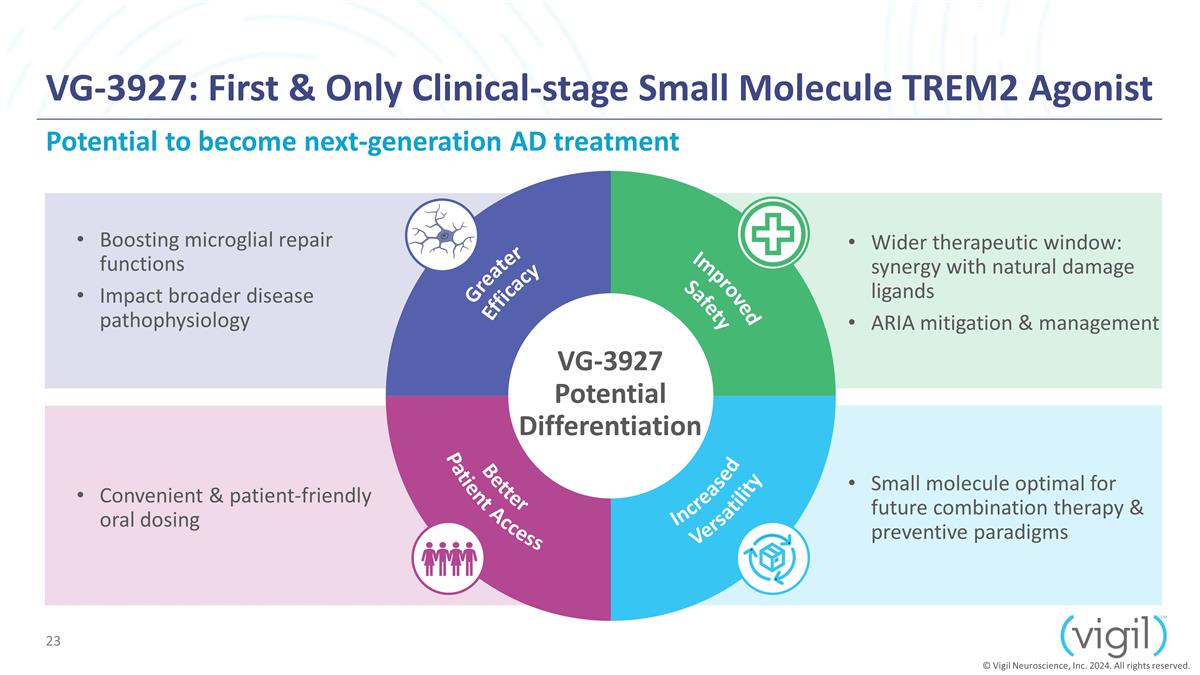
Increased Versatility Improved
Safety VG-3927: First & Only Clinical-stage Small Molecule TREM2 Agonist VG-3927 Potential Differentiation Small molecule optimal for future combination therapy & preventive paradigms Wider therapeutic window: synergy with natural
damage ligands ARIA mitigation & management Convenient & patient-friendly oral dosing Greater Efficacy Better Patient Access © Vigil Neuroscience, Inc. 2024. All rights reserved. Potential to become next-generation AD treatment Boosting
microglial repair functions Impact broader disease pathophysiology
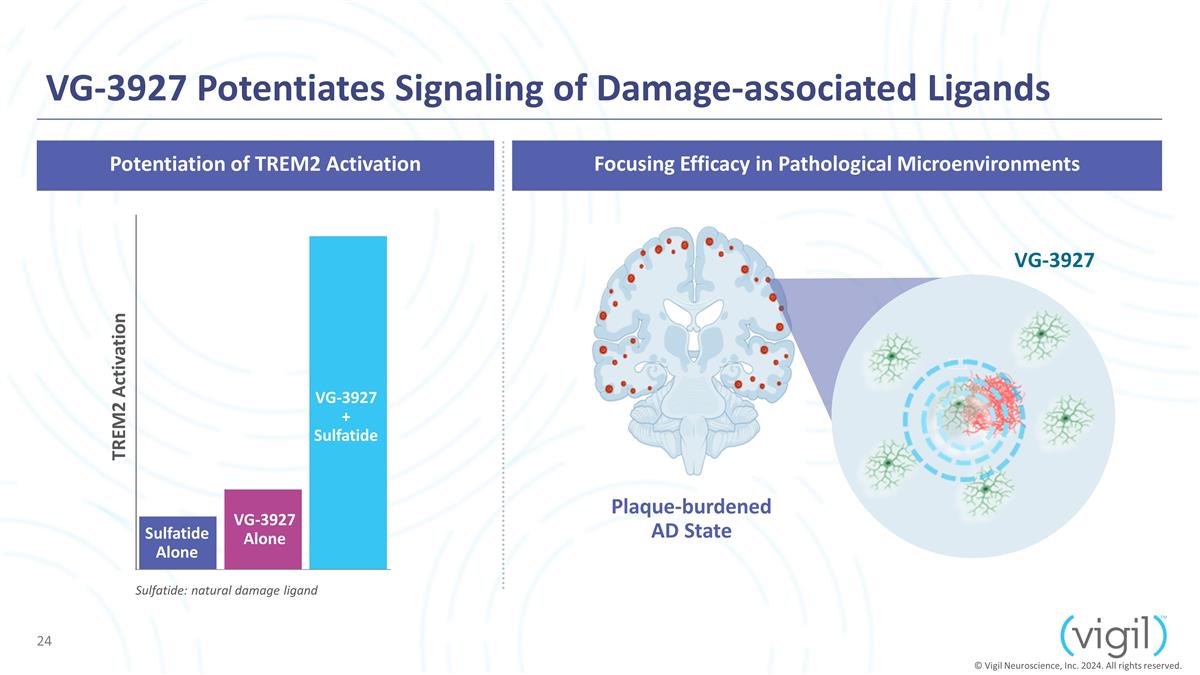
VG-3927 Potentiates Signaling of
Damage-associated Ligands Focusing Efficacy in Pathological Microenvironments Plaque-burdened AD State Potentiation of TREM2 Activation VG-3927 Sulfatide Alone VG-3927 Alone VG-3927 + Sulfatide TREM2 Activation © Vigil Neuroscience, Inc. 2024.
All rights reserved. Sulfatide: natural damage ligand
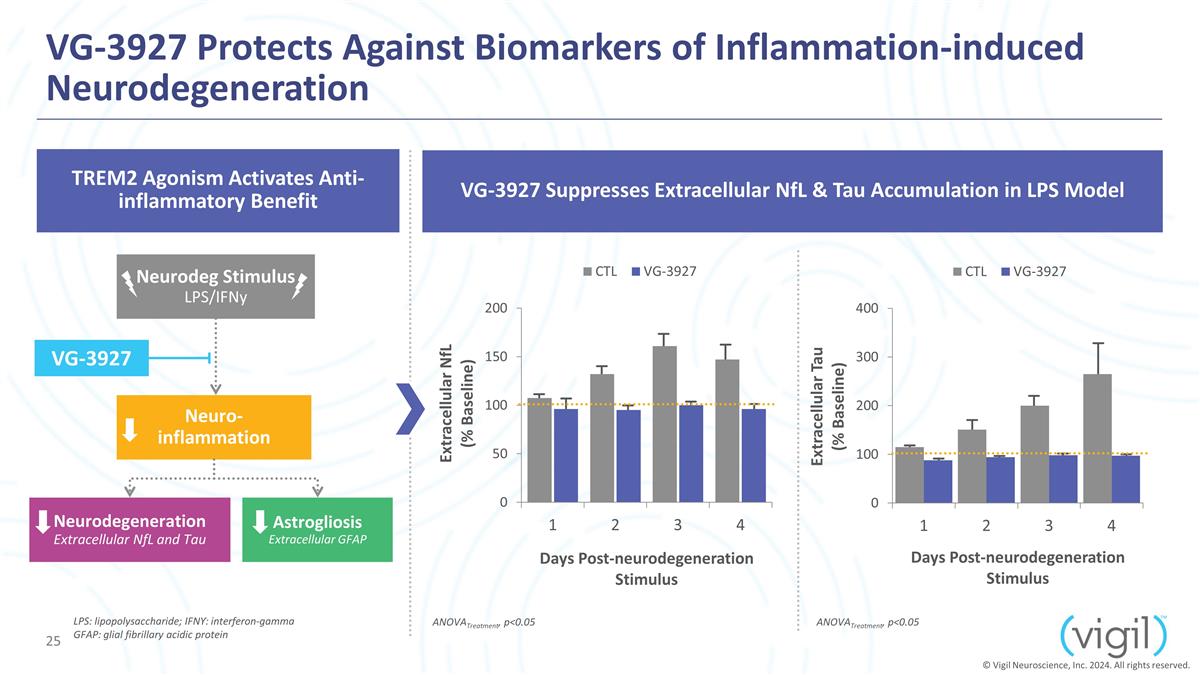
VG-3927 Protects Against Biomarkers
of Inflammation-induced Neurodegeneration ANOVATreatment, p<0.05 VG-3927 Suppresses Extracellular NfL & Tau Accumulation in LPS Model TREM2 Agonism Activates Anti-inflammatory Benefit VG-3927 Neuro- inflammation Neurodeg Stimulus LPS/IFNy
Neurodegeneration Extracellular NfL and Tau Astrogliosis Extracellular GFAP Days Post-neurodegeneration Stimulus Days Post-neurodegeneration Stimulus ANOVATreatment, p<0.05 LPS: lipopolysaccharide; IFNƳ: interferon-gamma GFAP: glial
fibrillary acidic protein © Vigil Neuroscience, Inc. 2024. All rights reserved.
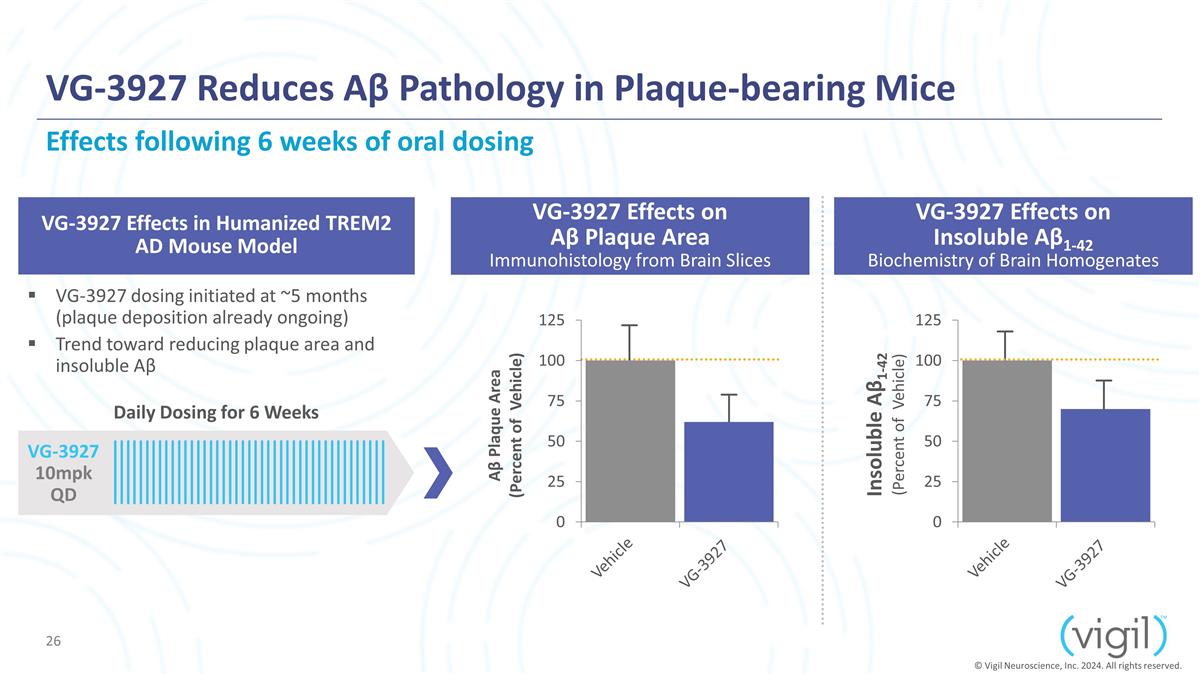
VG-3927 Reduces Aβ Pathology
in Plaque-bearing Mice VG-3927 Effects in Humanized TREM2 AD Mouse Model VG-3927 dosing initiated at ~5 months (plaque deposition already ongoing) Trend toward reducing plaque area and insoluble Aβ Daily Dosing for 6 Weeks VG-3927 10mpk QD
Effects following 6 weeks of oral dosing VG-3927 Effects on Aβ Plaque Area Immunohistology from Brain Slices VG-3927 Effects on Insoluble Aβ1-42 Biochemistry of Brain Homogenates © Vigil Neuroscience, Inc. 2024. All rights
reserved.
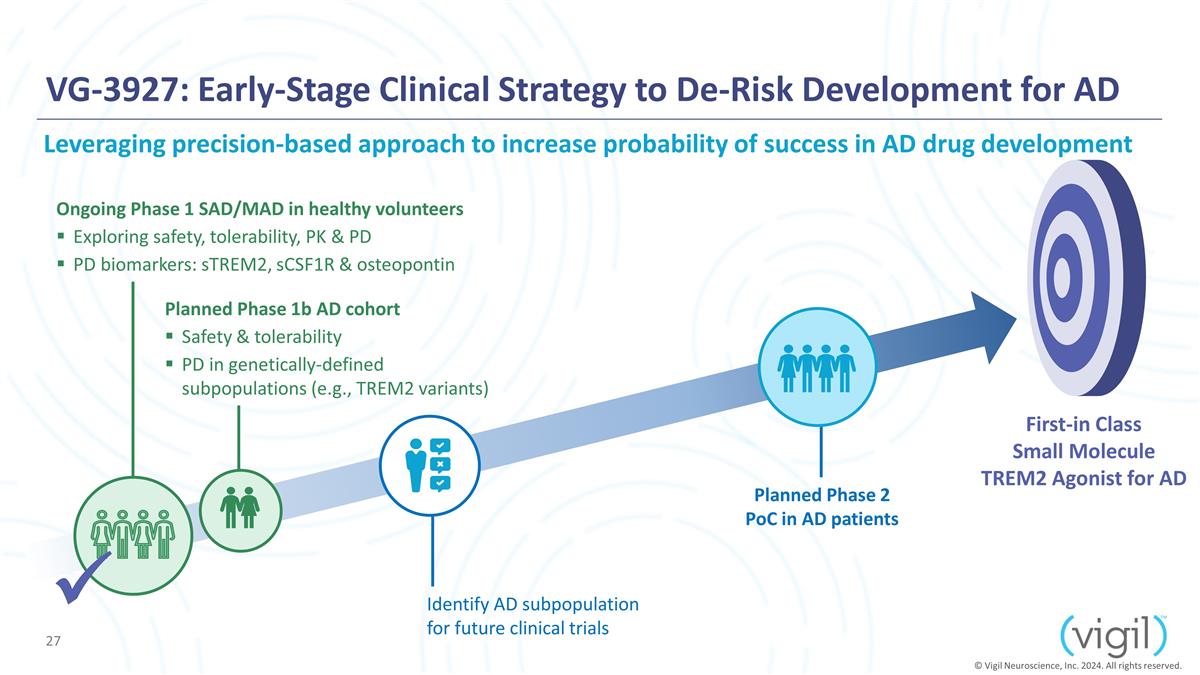
Ongoing Phase 1 SAD/MAD in healthy
volunteers Exploring safety, tolerability, PK & PD PD biomarkers: sTREM2, sCSF1R & osteopontin Planned Phase 1b AD cohort Safety & tolerability PD in genetically-defined subpopulations (e.g., TREM2 variants) Identify AD subpopulation for
future clinical trials Planned Phase 2 PoC in AD patients Leveraging precision-based approach to increase probability of success in AD drug development First-in Class Small Molecule TREM2 Agonist for AD © Vigil Neuroscience, Inc. 2024. All
rights reserved. ü VG-3927: Early-Stage Clinical Strategy to De-Risk Development for AD

Corporate Overview © Vigil
Neuroscience, Inc. 2024. All rights reserved.
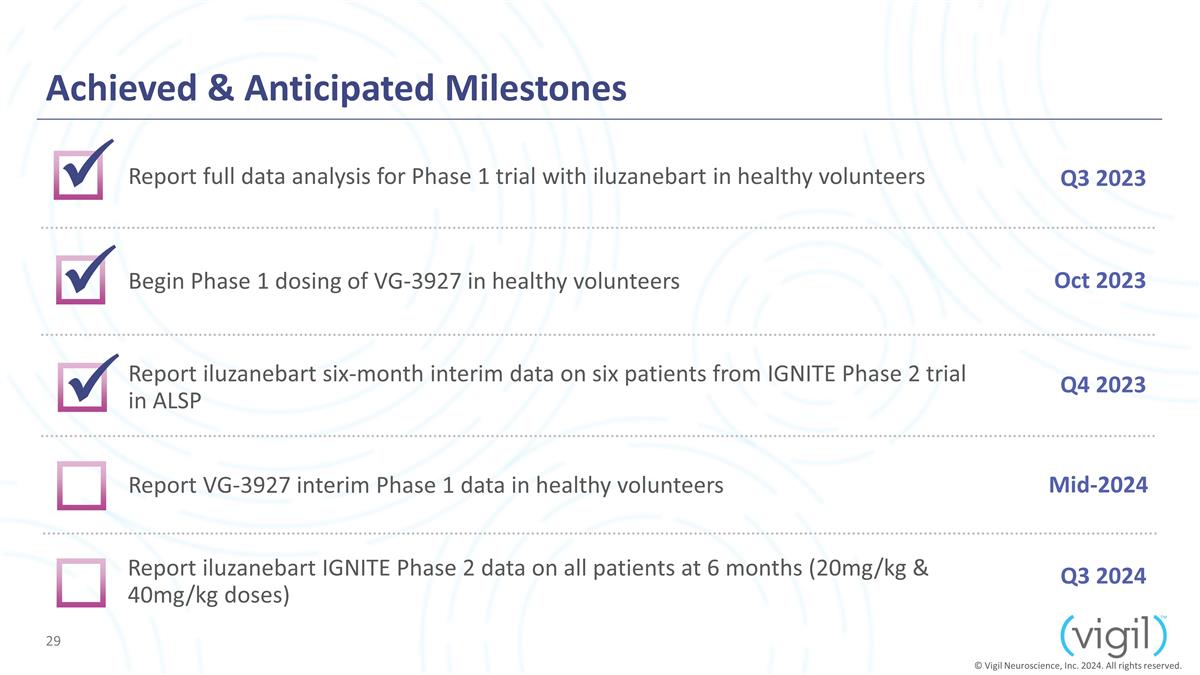
Achieved & Anticipated
Milestones Report VG-3927 interim Phase 1 data in healthy volunteers Mid-2024 © Vigil Neuroscience, Inc. 2024. All rights reserved. Report full data analysis for Phase 1 trial with iluzanebart in healthy volunteers Oct 2023 Q4 2023 Begin Phase
1 dosing of VG-3927 in healthy volunteers Q3 2023 ü Report iluzanebart six-month interim data on six patients from IGNITE Phase 2 trial in ALSP ü ü Report iluzanebart IGNITE Phase 2 data on all patients at 6 months (20mg/kg &
40mg/kg doses) Q3 2024
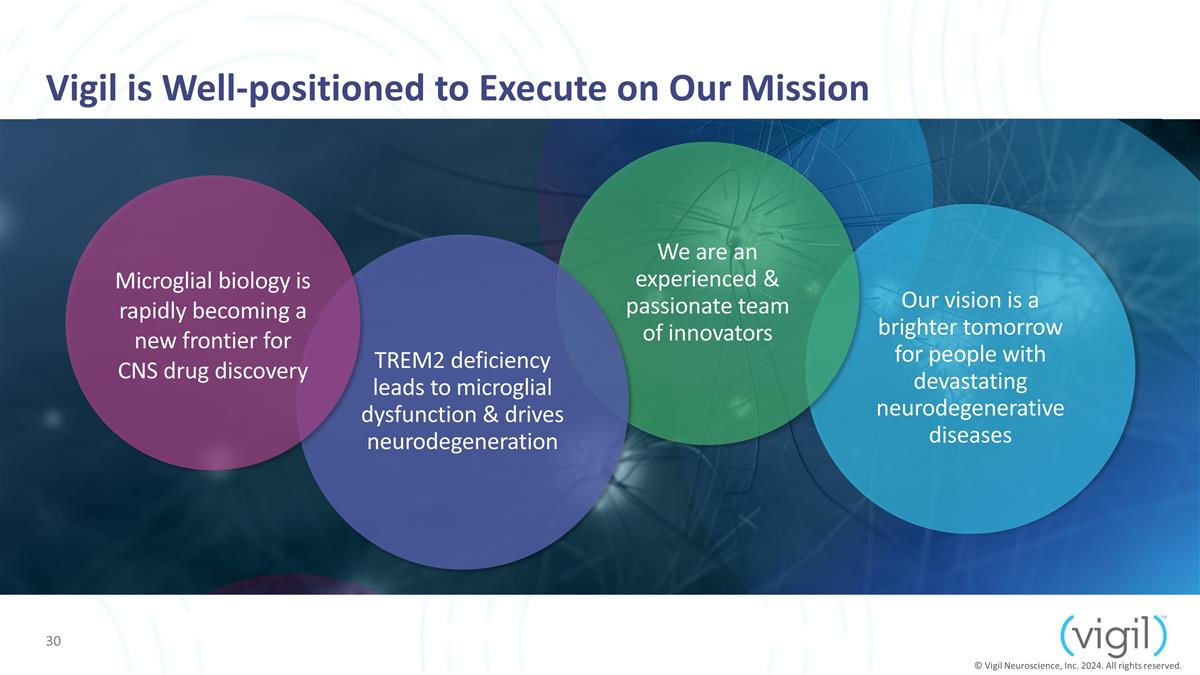
Vigil is Well-positioned to Execute
on Our Mission Our vision is a brighter tomorrow for people with devastating neurodegenerative diseases Microglial biology is rapidly becoming a new frontier for CNS drug discovery TREM2 deficiency leads to microglial dysfunction & drives
neurodegeneration We are an experienced & passionate team of innovators © Vigil Neuroscience, Inc. 2024. All rights reserved.
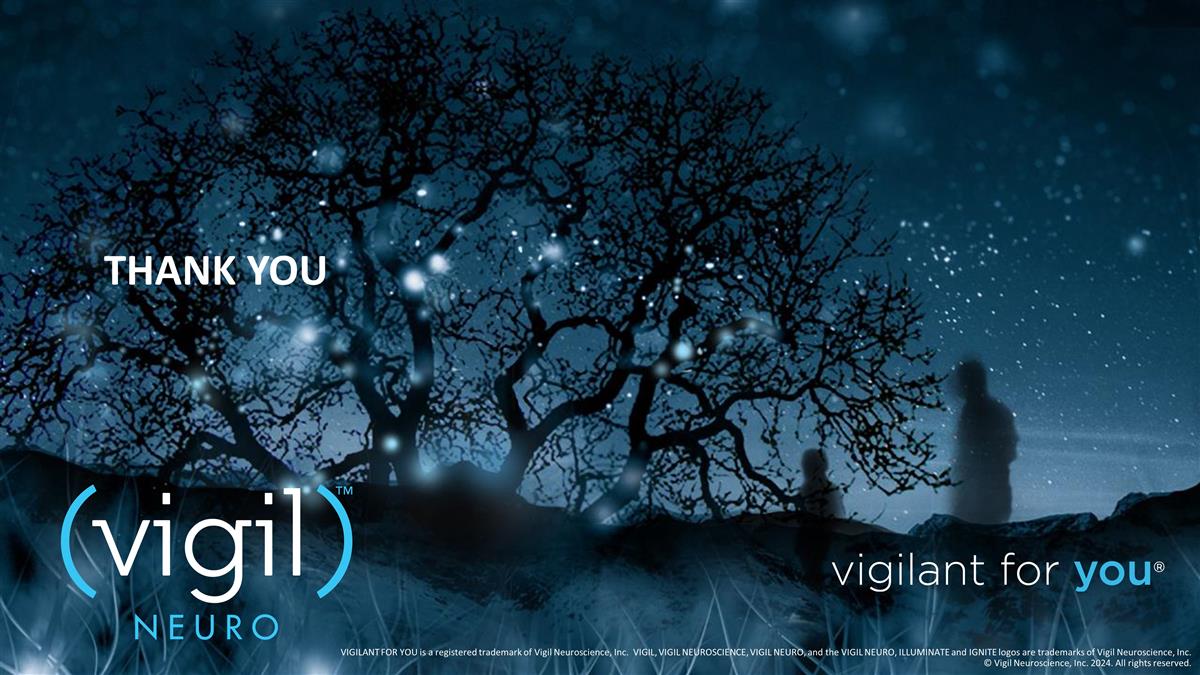
THANK YOU VIGILANT FOR YOU is a
registered trademark of Vigil Neuroscience, Inc. VIGIL, VIGIL NEUROSCIENCE, VIGIL NEURO, and the VIGIL NEURO, ILLUMINATE and IGNITE logos are trademarks of Vigil Neuroscience, Inc. © Vigil Neuroscience, Inc. 2024. All rights
reserved.
v3.23.4
Document and Entity Information
|
Jan. 11, 2024 |
| Cover [Abstract] |
|
| Amendment Flag |
false
|
| Entity Central Index Key |
0001827087
|
| Document Type |
8-K
|
| Document Period End Date |
Jan. 11, 2024
|
| Entity Registrant Name |
VIGIL NEUROSCIENCE, INC.
|
| Entity Incorporation State Country Code |
DE
|
| Entity File Number |
001-41200
|
| Entity Tax Identification Number |
85-1880494
|
| Entity Address, Address Line One |
Vigil Neuroscience, Inc.
|
| Entity Address, Address Line Two |
100 Forge Road
|
| Entity Address, Address Line Three |
Suite 700
|
| Entity Address, City or Town |
Watertown
|
| Entity Address, State or Province |
MA
|
| Entity Address, Postal Zip Code |
02472
|
| City Area Code |
(857)
|
| Local Phone Number |
254-4445
|
| Written Communications |
false
|
| Soliciting Material |
false
|
| Pre Commencement Tender Offer |
false
|
| Pre Commencement Issuer Tender Offer |
false
|
| Security 12b Title |
Common Stock, $0.0001 par value per share
|
| Trading Symbol |
VIGL
|
| Security Exchange Name |
NASDAQ
|
| Entity Emerging Growth Company |
true
|
| Entity Ex Transition Period |
false
|
| X |
- DefinitionBoolean flag that is true when the XBRL content amends previously-filed or accepted submission.
| Name: |
dei_AmendmentFlag |
| Namespace Prefix: |
dei_ |
| Data Type: |
xbrli:booleanItemType |
| Balance Type: |
na |
| Period Type: |
duration |
|
| X |
- DefinitionFor the EDGAR submission types of Form 8-K: the date of the report, the date of the earliest event reported; for the EDGAR submission types of Form N-1A: the filing date; for all other submission types: the end of the reporting or transition period. The format of the date is YYYY-MM-DD.
| Name: |
dei_DocumentPeriodEndDate |
| Namespace Prefix: |
dei_ |
| Data Type: |
xbrli:dateItemType |
| Balance Type: |
na |
| Period Type: |
duration |
|
| X |
- DefinitionThe type of document being provided (such as 10-K, 10-Q, 485BPOS, etc). The document type is limited to the same value as the supporting SEC submission type, or the word 'Other'.
| Name: |
dei_DocumentType |
| Namespace Prefix: |
dei_ |
| Data Type: |
dei:submissionTypeItemType |
| Balance Type: |
na |
| Period Type: |
duration |
|
| X |
- DefinitionAddress Line 1 such as Attn, Building Name, Street Name
| Name: |
dei_EntityAddressAddressLine1 |
| Namespace Prefix: |
dei_ |
| Data Type: |
xbrli:normalizedStringItemType |
| Balance Type: |
na |
| Period Type: |
duration |
|
| X |
- DefinitionAddress Line 2 such as Street or Suite number
| Name: |
dei_EntityAddressAddressLine2 |
| Namespace Prefix: |
dei_ |
| Data Type: |
xbrli:normalizedStringItemType |
| Balance Type: |
na |
| Period Type: |
duration |
|
| X |
- DefinitionAddress Line 3 such as an Office Park
| Name: |
dei_EntityAddressAddressLine3 |
| Namespace Prefix: |
dei_ |
| Data Type: |
xbrli:normalizedStringItemType |
| Balance Type: |
na |
| Period Type: |
duration |
|
| X |
- Definition
+ References
+ Details
| Name: |
dei_EntityAddressCityOrTown |
| Namespace Prefix: |
dei_ |
| Data Type: |
xbrli:normalizedStringItemType |
| Balance Type: |
na |
| Period Type: |
duration |
|
| X |
- DefinitionCode for the postal or zip code
| Name: |
dei_EntityAddressPostalZipCode |
| Namespace Prefix: |
dei_ |
| Data Type: |
xbrli:normalizedStringItemType |
| Balance Type: |
na |
| Period Type: |
duration |
|
| X |
- DefinitionName of the state or province.
| Name: |
dei_EntityAddressStateOrProvince |
| Namespace Prefix: |
dei_ |
| Data Type: |
dei:stateOrProvinceItemType |
| Balance Type: |
na |
| Period Type: |
duration |
|
| X |
- DefinitionA unique 10-digit SEC-issued value to identify entities that have filed disclosures with the SEC. It is commonly abbreviated as CIK. Reference 1: http://www.xbrl.org/2003/role/presentationRef
-Publisher SEC
-Name Exchange Act
-Number 240
-Section 12
-Subsection b-2
| Name: |
dei_EntityCentralIndexKey |
| Namespace Prefix: |
dei_ |
| Data Type: |
dei:centralIndexKeyItemType |
| Balance Type: |
na |
| Period Type: |
duration |
|
| X |
- DefinitionIndicate if registrant meets the emerging growth company criteria. Reference 1: http://www.xbrl.org/2003/role/presentationRef
-Publisher SEC
-Name Exchange Act
-Number 240
-Section 12
-Subsection b-2
| Name: |
dei_EntityEmergingGrowthCompany |
| Namespace Prefix: |
dei_ |
| Data Type: |
xbrli:booleanItemType |
| Balance Type: |
na |
| Period Type: |
duration |
|
| X |
- DefinitionCommission file number. The field allows up to 17 characters. The prefix may contain 1-3 digits, the sequence number may contain 1-8 digits, the optional suffix may contain 1-4 characters, and the fields are separated with a hyphen.
| Name: |
dei_EntityFileNumber |
| Namespace Prefix: |
dei_ |
| Data Type: |
dei:fileNumberItemType |
| Balance Type: |
na |
| Period Type: |
duration |
|
| X |
- DefinitionTwo-character EDGAR code representing the state or country of incorporation.
| Name: |
dei_EntityIncorporationStateCountryCode |
| Namespace Prefix: |
dei_ |
| Data Type: |
dei:edgarStateCountryItemType |
| Balance Type: |
na |
| Period Type: |
duration |
|
| X |
- DefinitionThe exact name of the entity filing the report as specified in its charter, which is required by forms filed with the SEC. Reference 1: http://www.xbrl.org/2003/role/presentationRef
-Publisher SEC
-Name Exchange Act
-Number 240
-Section 12
-Subsection b-2
| Name: |
dei_EntityRegistrantName |
| Namespace Prefix: |
dei_ |
| Data Type: |
xbrli:normalizedStringItemType |
| Balance Type: |
na |
| Period Type: |
duration |
|
| X |
- DefinitionThe Tax Identification Number (TIN), also known as an Employer Identification Number (EIN), is a unique 9-digit value assigned by the IRS. Reference 1: http://www.xbrl.org/2003/role/presentationRef
-Publisher SEC
-Name Exchange Act
-Number 240
-Section 12
-Subsection b-2
| Name: |
dei_EntityTaxIdentificationNumber |
| Namespace Prefix: |
dei_ |
| Data Type: |
dei:employerIdItemType |
| Balance Type: |
na |
| Period Type: |
duration |
|
| X |
- DefinitionLocal phone number for entity.
| Name: |
dei_LocalPhoneNumber |
| Namespace Prefix: |
dei_ |
| Data Type: |
xbrli:normalizedStringItemType |
| Balance Type: |
na |
| Period Type: |
duration |
|
| X |
- DefinitionBoolean flag that is true when the Form 8-K filing is intended to satisfy the filing obligation of the registrant as pre-commencement communications pursuant to Rule 13e-4(c) under the Exchange Act. Reference 1: http://www.xbrl.org/2003/role/presentationRef
-Publisher SEC
-Name Exchange Act
-Number 240
-Section 13e
-Subsection 4c
| Name: |
dei_PreCommencementIssuerTenderOffer |
| Namespace Prefix: |
dei_ |
| Data Type: |
xbrli:booleanItemType |
| Balance Type: |
na |
| Period Type: |
duration |
|
| X |
- DefinitionBoolean flag that is true when the Form 8-K filing is intended to satisfy the filing obligation of the registrant as pre-commencement communications pursuant to Rule 14d-2(b) under the Exchange Act. Reference 1: http://www.xbrl.org/2003/role/presentationRef
-Publisher SEC
-Name Exchange Act
-Number 240
-Section 14d
-Subsection 2b
| Name: |
dei_PreCommencementTenderOffer |
| Namespace Prefix: |
dei_ |
| Data Type: |
xbrli:booleanItemType |
| Balance Type: |
na |
| Period Type: |
duration |
|
| X |
- DefinitionTitle of a 12(b) registered security. Reference 1: http://www.xbrl.org/2003/role/presentationRef
-Publisher SEC
-Name Exchange Act
-Number 240
-Section 12
-Subsection b
| Name: |
dei_Security12bTitle |
| Namespace Prefix: |
dei_ |
| Data Type: |
dei:securityTitleItemType |
| Balance Type: |
na |
| Period Type: |
duration |
|
| X |
- DefinitionName of the Exchange on which a security is registered. Reference 1: http://www.xbrl.org/2003/role/presentationRef
-Publisher SEC
-Name Exchange Act
-Number 240
-Section 12
-Subsection d1-1
| Name: |
dei_SecurityExchangeName |
| Namespace Prefix: |
dei_ |
| Data Type: |
dei:edgarExchangeCodeItemType |
| Balance Type: |
na |
| Period Type: |
duration |
|
| X |
- DefinitionBoolean flag that is true when the Form 8-K filing is intended to satisfy the filing obligation of the registrant as soliciting material pursuant to Rule 14a-12 under the Exchange Act. Reference 1: http://www.xbrl.org/2003/role/presentationRef
-Publisher SEC
-Name Exchange Act
-Section 14a
-Number 240
-Subsection 12
| Name: |
dei_SolicitingMaterial |
| Namespace Prefix: |
dei_ |
| Data Type: |
xbrli:booleanItemType |
| Balance Type: |
na |
| Period Type: |
duration |
|
| X |
- DefinitionTrading symbol of an instrument as listed on an exchange.
| Name: |
dei_TradingSymbol |
| Namespace Prefix: |
dei_ |
| Data Type: |
dei:tradingSymbolItemType |
| Balance Type: |
na |
| Period Type: |
duration |
|
| X |
- DefinitionBoolean flag that is true when the Form 8-K filing is intended to satisfy the filing obligation of the registrant as written communications pursuant to Rule 425 under the Securities Act. Reference 1: http://www.xbrl.org/2003/role/presentationRef
-Publisher SEC
-Name Securities Act
-Number 230
-Section 425
| Name: |
dei_WrittenCommunications |
| Namespace Prefix: |
dei_ |
| Data Type: |
xbrli:booleanItemType |
| Balance Type: |
na |
| Period Type: |
duration |
|
Vigil Neuroscience (NASDAQ:VIGL)
Historical Stock Chart
From Apr 2024 to May 2024
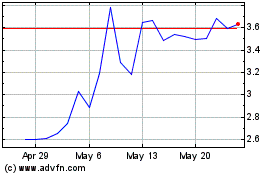
Vigil Neuroscience (NASDAQ:VIGL)
Historical Stock Chart
From May 2023 to May 2024
